216, Gijanghaean-ro, Gijang-eup, Busan, 46083, Republic of Korea TEL: 82-51-720-2114 FAX: 82-51-720-2054~5
Copyright(C) 2022 National Institute of Fisheries Science. All rights reserved.
[1] Developed standard material for shrimp disease diagnosis, a foundation for healthy shrimp production
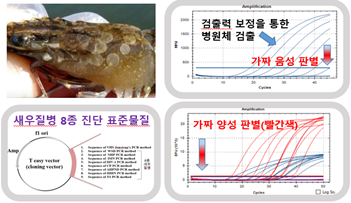
- Development and patent registration of original technology to produce the「new concept standard material for genetic testing」
- Succeeded in developing a technology to identify false-negative and false-positive results in real-time PCR (‘21)
- Verified its effectiveness by developing standard material to diagnose eight shrimp diseases and conducting joint research with EU reference laboratories
- Prevention of false-positive and false-negative results
- Contributed to healthy shrimp production with increased accuracy of disease diagnosis and reduced misdiagnosis
[2] Predicted changes in fisheries resources and optimal production time of aquaculture organisms under climate change
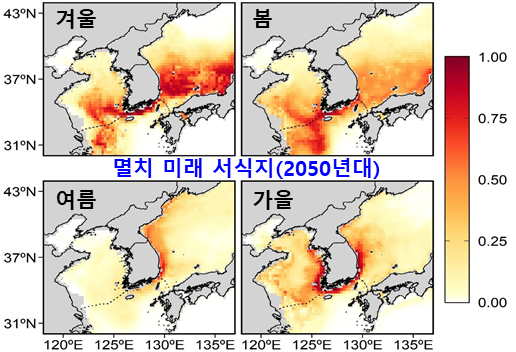
- Fisheries resources projection by applying climate change scenarios (IPCC AR5, AR6) to Korean waters
- Future habitat projection of major commercial fish species, estimation of the time for aquaculture organism production and seed collection
- Projection of the future of major coastal fisheries resources in the 2050s, under the impact of climate change
- Anchovyhabitat areas; projected to increase from winter to spring and to decrease from summer to fall
- Mackerelhabitat; projected to move northward and delayed time to move southward (East China Sea)
- LaverWando sea areas; projected to see reduced production period (about 30 days) and delayed time to collect seed (about 10 days)
[3] Developed raw materials for abalone and Hanwoo feed using Sargassum honeri, aquatic nuisance species
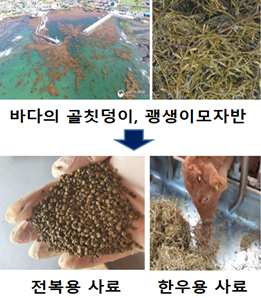
- Turned Sargassum honeri, the mass-generated seaweed, into the raw materials for ablone and Hanwoo feed
- Possible to replace up to 100% of existing sea mustard powder (40%) in abalone feed (Patent Application)
- Clarified that there was no problem in both ingestion and digestion when adding 5% of Sargassum honeri to existing Hanwoo feed (Patent Application)
- When used as the raw material for Hanwoo feed, Sargassum honeri reduced the amount of methane gas generated, a cause of global warming.
- Reduction in the amount of methane gas generated in the preliminary tests using microorganisms within cow’s stomach (20~30%)
- Won the ‘Encouragement Award’ at MOF Best Practice Contest for proactive public administration in the second half of 2021
[4] Developed processing technology to control physical property of seafood tailored for seniors and children and technology to maintain freshness
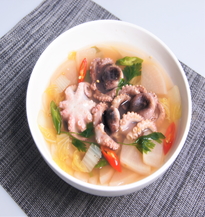
- Development of processing technology for controlling physical property of seafood
- Processing technology to control the physical property of seafood for seniors with difficulty in chewing
- Manufacturing method of softened seafood marinated in sauce (Patent Application No. 1020220045166)
- Development of technology for maintaining shellfish freshness during distribution process
- Freshness prolonged by 1~5 days through the application of low salinity carbonated water washing
- Launched a product adopting the technologies for physical property control and freshness maintenance
[5] Released 「Annual Report for Climate Change Trends in Fisheries, 2022」
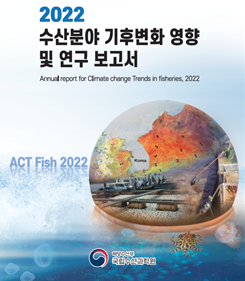
- Comparative analysis of impact and prospect of climate change in Korean waters, using scenario models and observation results
- Observation results confirmed the projection that ocean warming and stratification would reduce primary productivity and nutrients of the sea surface along with dominance of small phytoplankton
- Results of ocean climate models, based on greenhouse gas emissions scenarios, projected Korean sea areas to experience around 4℃ increase in 2100
- Analysis of the impact of climate change on fisheries industry and introduction of aquaculture technology development to cope with climate change
- Observation results confirmed the increased frequency of subtropical fish species emergence and the advanced occurrence time of paralytic shellfish toxins
- Introduction of technology development status in aquaculture for culture species and rearing methods under climate change
Raised awareness on climate change and shared the sense of crisis by distributing the report to fishery and policy sites
[6] Revealed the amount of a shoal of mackerel and anchovy resources in time and space using convergence detection technology
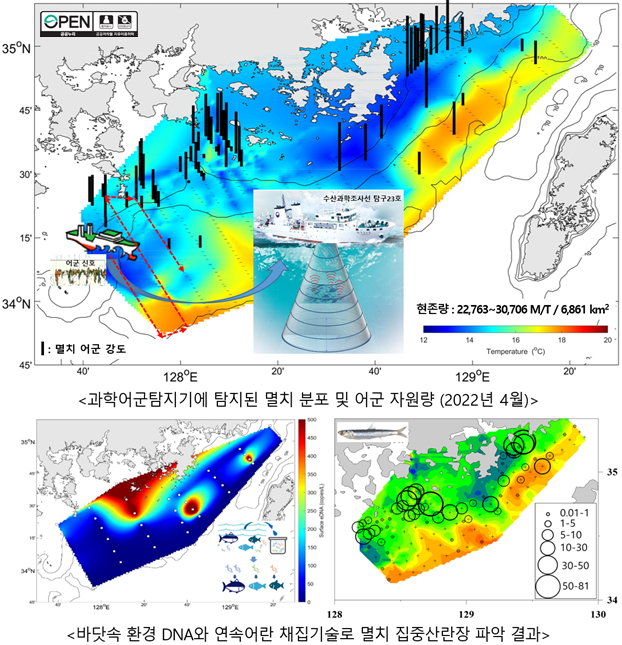
- Improved the correctness of resource estimation on a shoal of fish by combining fish finder, environmental DNA, and continuous underway fish egg sampling technology
- (Fish finder) Detected a shoal of mackerel and anchovy (adult fish) and estimated the amount of resources
- Mackerel Near Jeju Island (October) 12,283~15,305 tons (‘20), 26,852~27,898 tons (‘21)
- AnchovySouth Sea (April) 22,763~30,706 tons (‘22)
- (Environmental DNA) Confirmed spatial correlation between anchovy distribution and environmental DNA concentration
- Detected the high concentration of anchovy environmental DNA in the sea areas of the mid and east part of the South Sea
- (Continuous underway fish egg sampling) Identifying the distribution density of mackerel and anchovy eggs and the environment of spawning ground
- Mackerel West Sea (April) 174~5,436 eggs/1,000m3, southern East Sea (May) 47~1,037 eggs/1,000m3, water temperature 16~18℃
- AnchovyWest Sea (April) 1,684~81,831 eggs/1,000m3, southern East Sea (May) 530~61,176 eggs/1,000m3, water temperature 14~16℃
[7] Developed and commercialized a new anti-wrinkle substance found in the microorganism derived from golden sea squirt
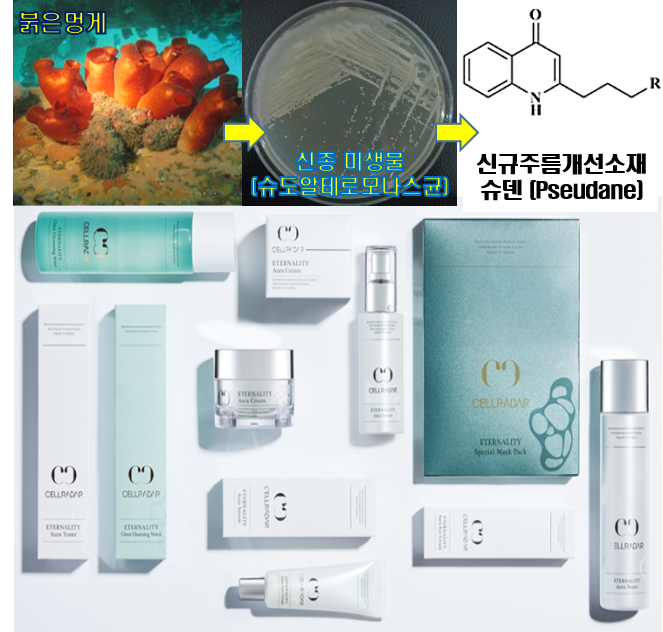
- Developed a new anti-wrinkle substance (Bio-Pseudane) produced by a new microorganism
- Analysis of structure and activity of Pseudane, a natural substance produced by Pseudoalteromonas sp. M2 strain
- Constructed mass production process by analyzing the optimal production condition, and developed it as a substance for functional cosmetics
- Launching and export of functional cosmetics with outstanding anti-wrinkle and whitening effect
- Verification of wrinkle improvement (inhibiting 60% of wrinkle generation enzyme) and whitening effect (inhibiting 15% of pigment production)
- More thermal-and-light stability and lower toxicity than existing anti-wrinkle substance, retinol
- Launching and export of the cosmetics through technology transfer, and three patent registrations regarding microorganism, substance, and production method
[8] Developed production technology for land-based sea mustard seed
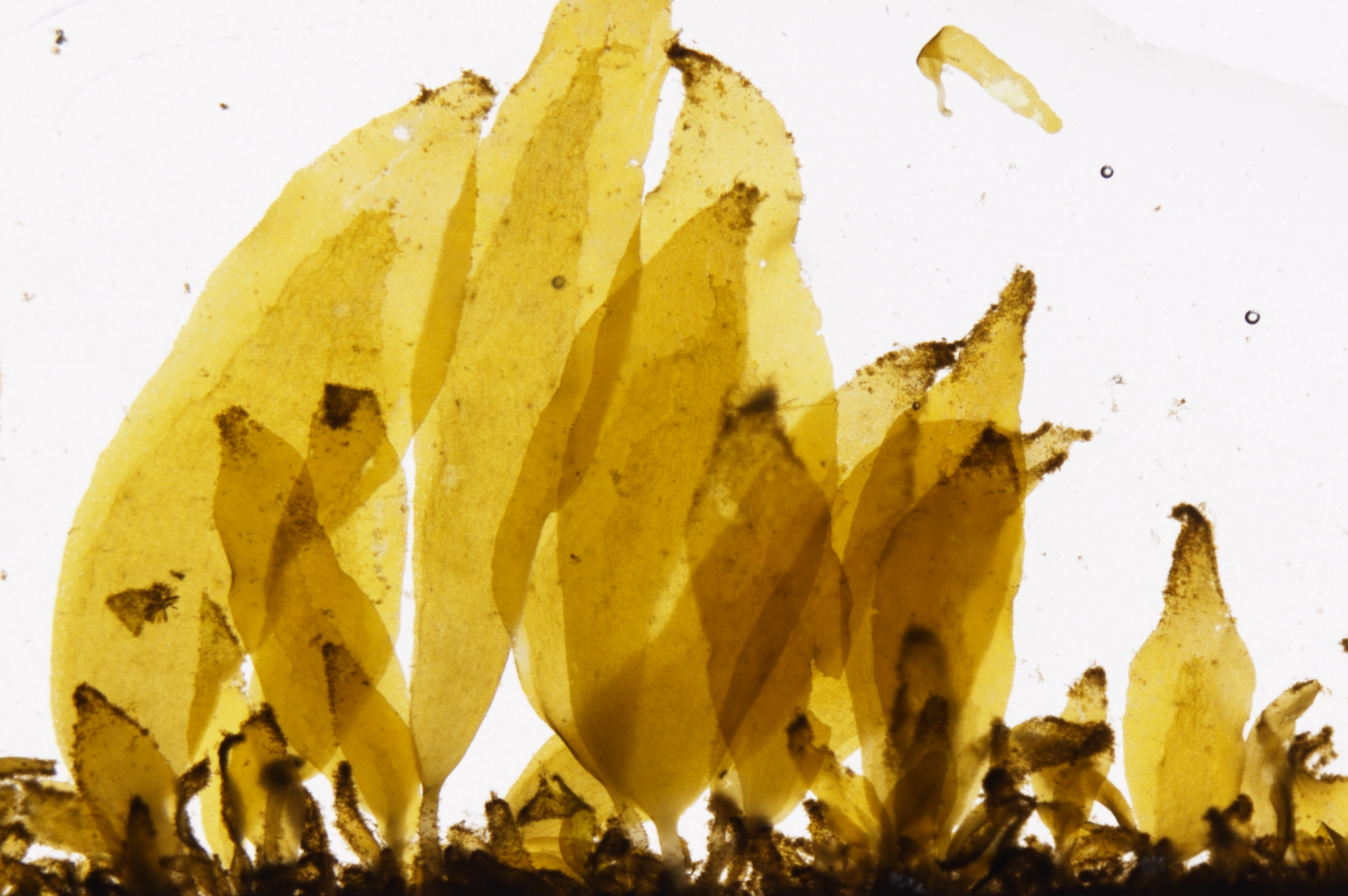
- Improved the production technology for sea mustard seed in land farming water tanks without temporary transplanting in oceans
- Production period shortened by 1.4 times (previous 60 days -> 40 days), the growth rate increased by 1.9 times (previous 4.0 mm → 7.6 mm)
- In experimental aquaculture, faster take rooting and more excellent adaptability to the sea environment compared to temporary transplanting
- Improved the existing seed production problem of slow growth rate in early stage (free from temporary transplanting into aquaculture site)
- Possible to produce seed regardless natural disasters (high water temperature, typhoon, etc.), reduce labor and production costs, and improve productivity, thereby increasing the income of seaweed culture households and enhancing their convenience
[9] Established a foundation for stabilizing the production of high-quality Pyropia dentata
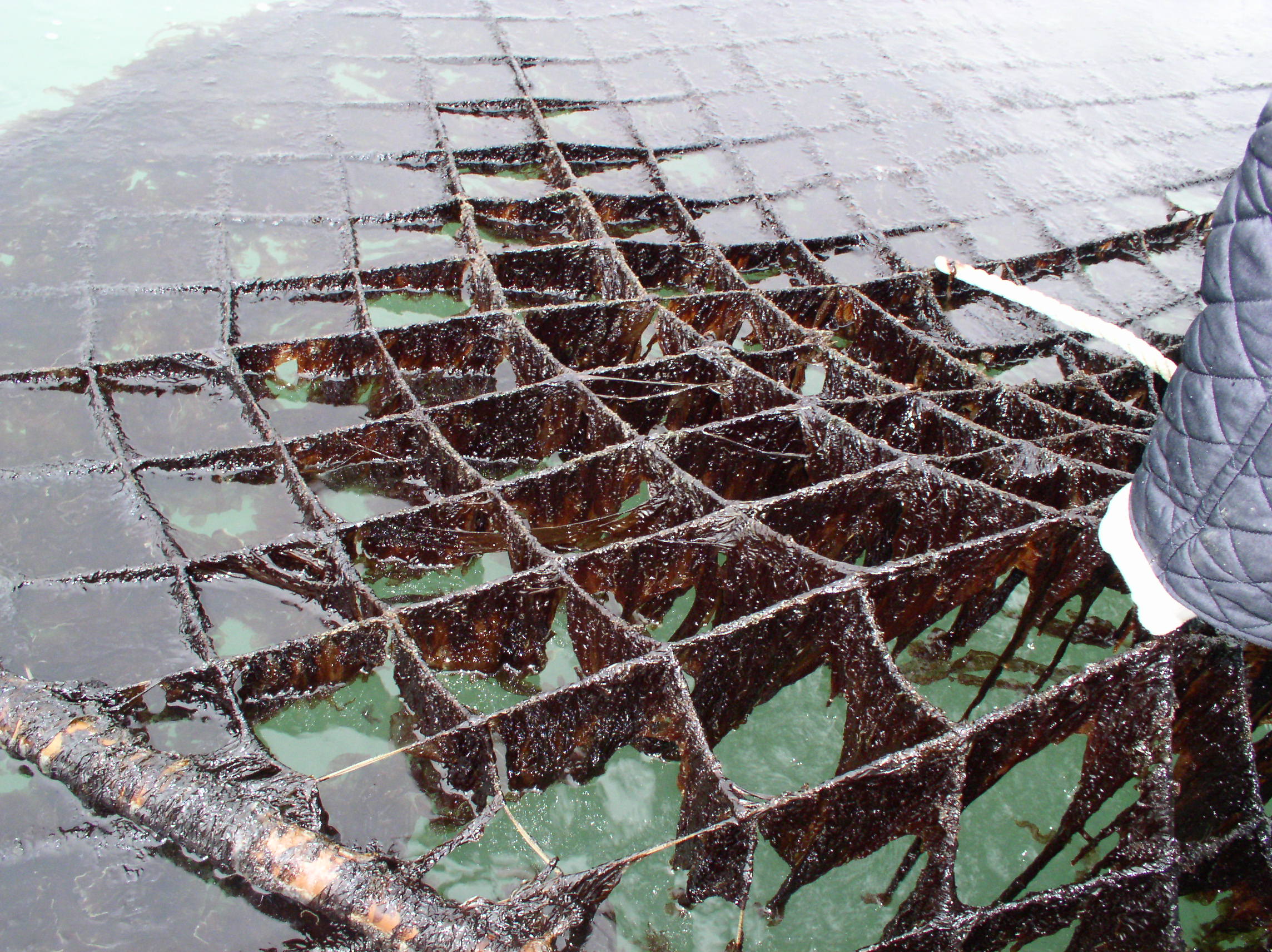
- Confirmed that Porphyra haitanensis did not inhabit in Korean coastal waters through DNA analysis on natural populations of stone laver, thereby providing scientific ground for interrupting the distribution of Chinese Porphyra haitanensis, which is similar to high-quality Pyropia dentata
- Survey stations Gyeonggi (25), Chungnam (37), Jeonbuk (27), Jeonnam (144), Gyeongnam (64), Busan (8), Ulsan (10), Gyeongbuk (25), Jeju (77)
- Reduced the usage of the illegal seed, Porphyra haitanensis, led by preemptive free distribution of high quality Pyropia dentata
- Generated an economic effect of KRW 26.7 billion through preemptive free distribution of 1,648g high quality Pyropia dentata new variety
[10] Developed AI-based genetic analysis technology for native abalone
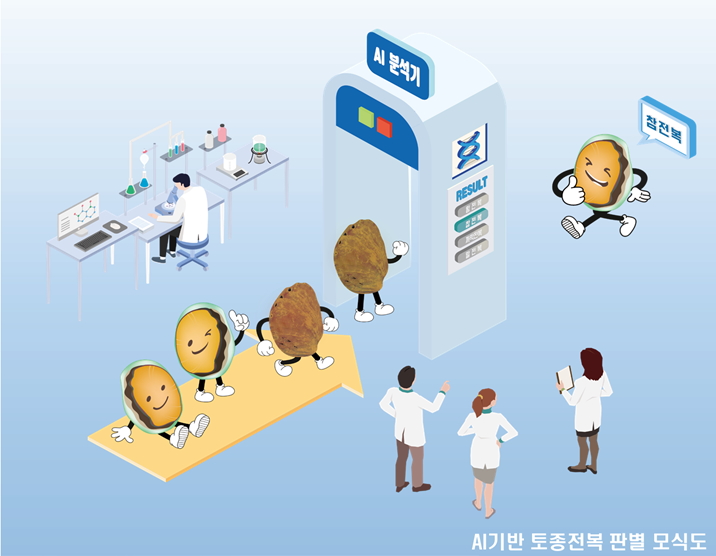
- Establishment of classification technology for native abalone facilitating artificial intelligence (AI) technique
- Secured genetic markers for differentiating abalone varieties through comparative analysis of genome information on Haliotis discus hannai, Haliotis discus, Haliotis gigantea, and Haliotis madaka
- Improvement of analysis accuracy by developing a classification pipeline for abalone varieties (More than 98%)
- Genetic markers and methods using the same for differentiating abalone varieties (Patent Registration)
- Technical cooperation for the production of native abalone facilitating abalone classification technology
- MOU signing and collaborative research with Gyeongsangbukdo Fishery Resources Institute for the conservation of H. madaka in Dokdo Island, ROK
- Support for the project on production and release of native abalone at relevant organizations (2,436 entities)
[1] Introduced a new era of underwater unmanned fishery resource surveillance!
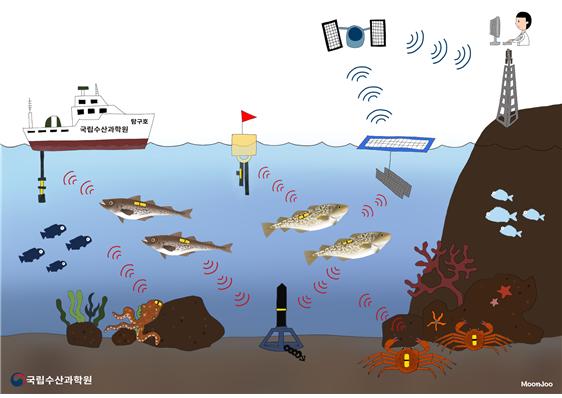
- Implementation (development) of snow crab remote search technology using unmanned observation equipment for the first time in Korea
- Technology that collects and transmits snow crab location, water temperature, and water depth data in real time through satellite communication and internet network
- Investigation of pollock, octopus, and cod behavioral characteristics using bio-logging equipment for the first time in Korea
- PollackMoved to the submarine canyon (water temperature 1℃, water depth of 200m or less, steep terrain) presumed to be their main habitat
- Capsicum octopusPrepared for spawning after moving and settling in coastal areas with a water depth of 15.1-34.8m and a water temperature of 0.8-11.3℃
- CodAfter resting for 20-53 days in the southeastern sea area of Geoje (water depth 24-36m, water temperature 5.9-10.6℃), moved to their feeding grounds
[2] Developed and distributed 'wireless net hauler emergency stop devices' to reduce safety accidents of fisherfolk
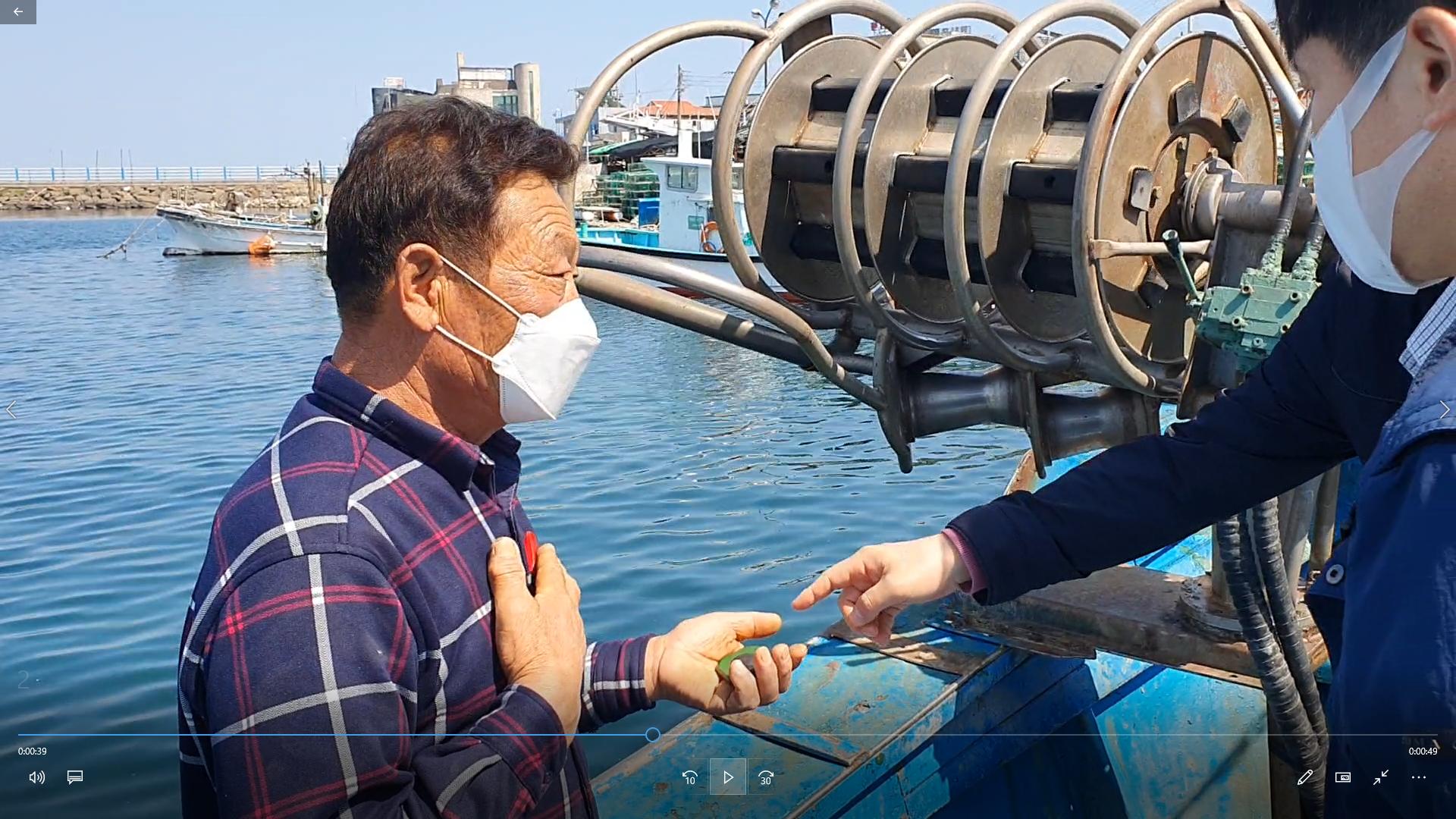
- Development of a device that can urgently stop a net hauler wirelessly
- Patent registration, technology transfer, and commercialization support for industrialization of related technologies
- Patent registrationWearable crew safety device for fishing boats (10-226015, '20.11.)
- Non-exclusive license contract and technology transfer of state-owned patents ('21.5.)
- On-site demonstration of related technologies for the Ministry of Oceans and Fisheries, National Federation of Fisheries Cooperatives, and local governments
- On-site demonstrationinister ('21.15.), Fishing Boat Safety Policy Division and National Federation of Fisheries Cooperatives ('21.4.), Gyeongsangbuk-do ('21.5.), Field Director's Office ('21.10.), Head of the Maritime Safety Bureau ('21.10.)
- Supply of net hauler emergency stop devices to 1,180 ships in 2021
[3] Succeeded in developing an oral vaccine to prevent flatfish streptococcus for the first time in Korea
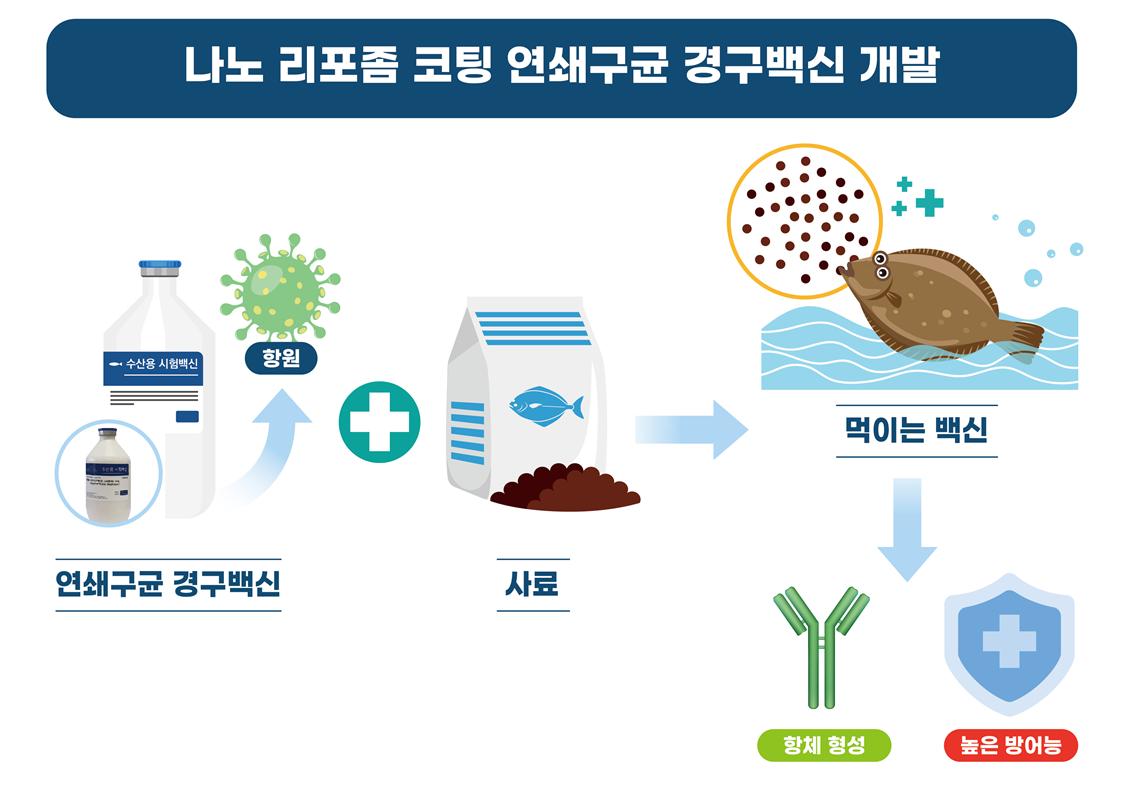
- Development of source technology for 'nano-liposome coating oral vaccine for fish' that is easy to give
- Patent registration of antigen manufacturing technology coated with liposome and chitosan for antigen protection in the fish stomach (2019)
- Success in oral vaccine commercialization and field verification through joint research with manufacturers
- Confirmation of high antibody formation rate (70%) and high protection rate (50%) after oral vaccine use at aquaculture sites (Jeju 2, Pohang 1)
- Improved productivity by inducing innovation in aquatic vaccination methods and reducing fish stress
- Reduced manpower and expenses (25 won/fish) for fish vaccination and reduced disease occurrence by more than 45 billion won per year
[4] Restored traditional kelp(Kjellmaniella crassifolia) using aquaculture techniques and establishment of a foundation for industrialization
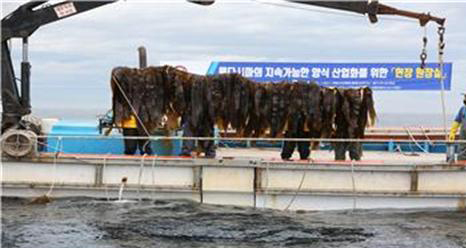
- Secured F0 generation gametes through procurement of mature lobular fragments
- Established aquaculture basis through pure separation of male and female gametes (F0∼F3), cultivation, and proliferation
- Developed management technology through identification and application of optimal cultivation conditions for traditional kelp (Kjellmaniella crassifolia)
- It is possible to secure mature fronds (October) by adjusting the water depth (5→15→25m) according to the breeding environment
- In 2021, applied for a patent for “Natural water depth control aquaculture technology of traditional kelp (Kjellmaniella crassifolia)”
- Secured sustainability for aquaculture industrialization by procuring a large number of mature plants
- Completed 400 frames of traditional kelp (Kjellmaniella crassifolia) seeds, planned to sell 300 frames ('21. 12)
[5] Secured research quotas for Antarctic toothfish (Mero) through scientific research
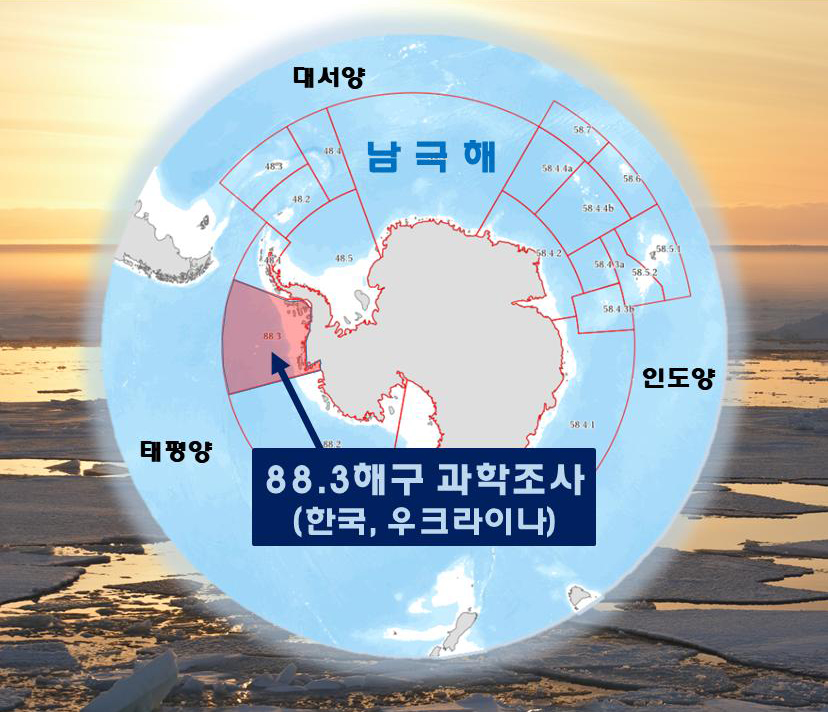
- Secured 110 tons of Antarctic toothfish (Mero) to meet the research quota of the CCAMLR (Committee for the Conservation of Antarctic Marine Living Resources)
- With establishment of a systematic surveillance plan through years of research on Antarctic toothfish and collaboration with member countries (Ukraine), Korea has been able to achieve this approval of the surveillance plan from CCAMLR, which has strict preservation measures.
- Generated economic profit of about KRW 1.5 billion and created jobs by securing research quota of Antarctic toothfish
- Collected unique scientific information from the 88.3 zone (no toothfish fishing zone) of the Antarctic Ocean
- Established surveillance and research infrastructure related to the Antarctic Ocean, which is difficult to access, through industry-university-research institute collaboration
- Scientifically contributed to the comprehensive management of the Antarctic Ocean by collecting various information related to the Antarctic Ocean
[6] Developed high value-added hybrid grouper breeding technology for responding to high water temperatures
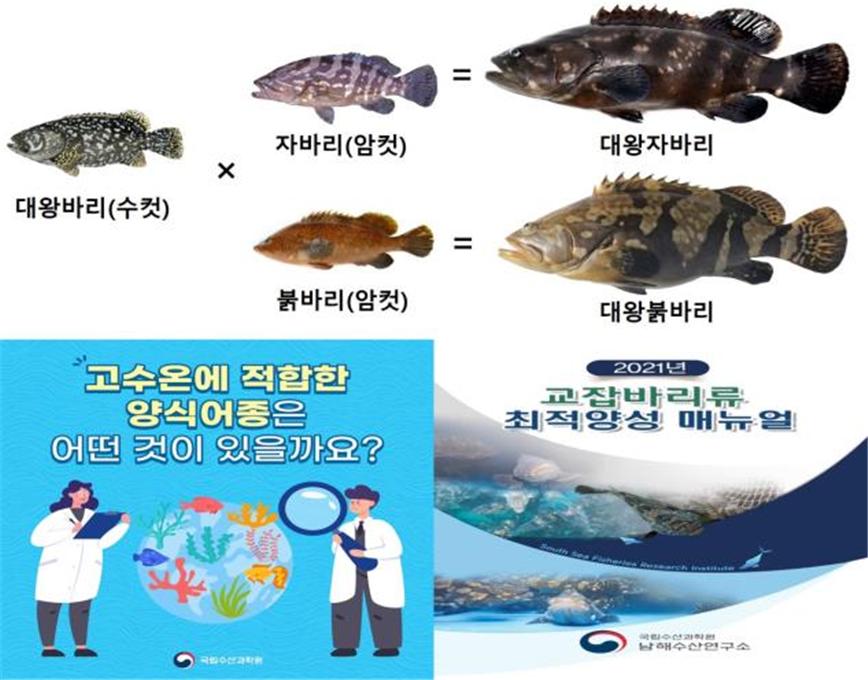
- Succeeded in developing high value-added hybrid grouper breeding technology (Giant red-spotted grouper, Giant kelp grouper)
- Succeeded in developing and disseminated standard breeding technology for optimal breeding of hybrid groupers
- Cultivation conditionsOptimal growth water temperature 28℃, salinity 25 psu or more, lower survival limit water temperature 12-14℃ or less, ammonia 1ppm or less, feeding amount and frequency 1-2% of body weight, 3 times/day
- Investigated winter conditions for crossbreeds in sea cages and secured suitable winter areas in Jeonnam
- Winter water temperature/sea area(Giant red-spotted grouper) over 12℃, (Giant kelp grouper) over 14℃/Geomun Island
- Expanded and disseminated crossbreeding methods for a future strategic aquaculture breed in response to high water temperature and climate change
- Disseminated technology allowing year-round cultivation in sea cages due to the success of wintering the high-temperature hybrid grouper, Giant red-spotted grouper
- Made a significant contribution to fisherfolk’s income by replacing high-temperature damaged fish species and short-term intensive training/shipping
[7] Developed functional cosmetic materials for skin using Dokdo microorganisms
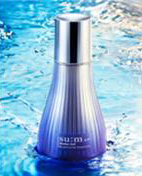
- Selected useful Lactobacillus lactic acid bacteria from Dokdo
- Procured lactic acid bacteria with excellent antibacterial activity against harmful skin bacteria (pyogenes, Pseudomonas aeruginosa, candida, etc.)
- Identified lactic acid bacteria, and established an international microbiological deposit (Lactbacillus pentosus NIFSLG-1) and optimal conditions for mass production of antibacterial substances
- Launched skin prebiotics* product with skin function improvement effect
- Microorganisms applied to protect skin health, such as strengthening skin immunity and moisturizing power, and relieving inflammation
- Skin moisturizing (44%↑), brightening (74%↑), wrinkle improvement (20%↑), inflammation relief and soothing (32%↓), increase in beneficial skin bacteria (15%↑)/decrease in harmful bacteria (7.1%↓)
- Launched skin prebiotics products in 2021 (LG Household & Health Care Co., Ltd., Su:m 37°)
[8] Succeeded in developing hypoxic water mass big data and predicting technology of hypoxic water mass fluctuation
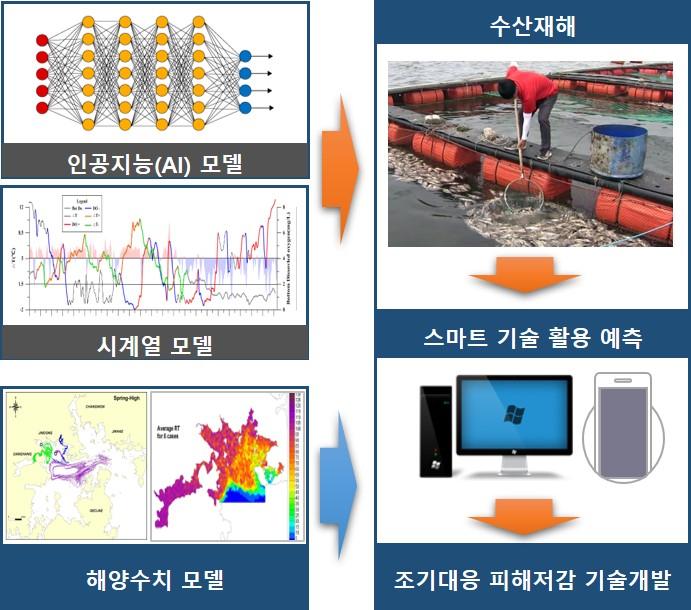
- Expanded and operated a continuous observation system for each layer in real time (production of big data)
- Observation depth/observation time: (∼'20) 13 locations/3 layers/1 hour intervals → ('21) 14 locations/up to 9 layers/1 minute intervals
- Developed a continuous observation system for each layer → Investigated the mechanism of vertical fluctuation of hypoxia → Investigated relevance between hypoxic water mass and mortality
- Developed artificial intelligence hypoxic water mass prediction technology by collecting big data
- Developed artificial intelligence (machine learning, deep learning) algorithm for predicting the occurrence of hypoxic masses → Achieved 70% accuracy
- Reinforced the establishment of a two-way information communication system between NIFS and fisherfolk
- Operated social media with participation of fisherfolk (3 group chat rooms, 74 people) → Promptly provided real-time information on changes in hypoxia fishery environment
[9] Developed simple seafood customized for non-face-to-face consumption and published a cookbook
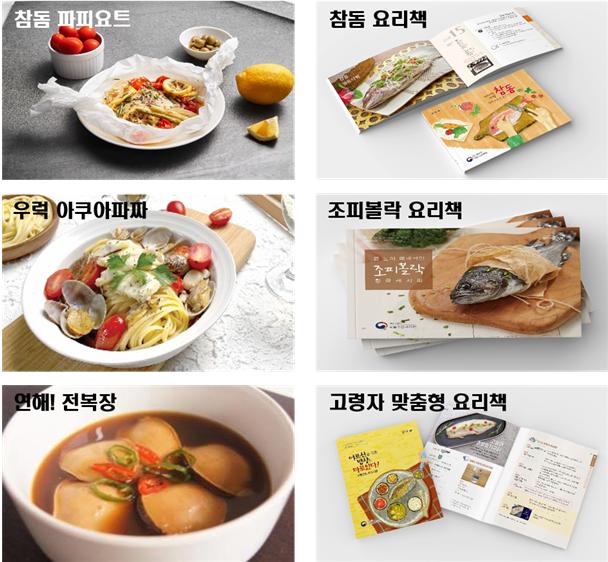
- Developed and industrialized HMR (Home Meal Replacement) seafood
- Commercialization of meal-kit products with patented fishy smell removal technology (Red seabream papillot, rockfish aquapazza) Generated sales by transferring recipe and patent technology to industry (approximately KRW 48,000,000)
- Development of soy sauce marinated abalone applied with softening technology (Soft! Soy sauce marinated abalone!)
- Developed recipes for simple meals to enjoy at home and issued a publication
- Developed 30 recipes using red seabream and rockfish, published and distributed cookbooks
- Developed 24 recipes for consistency adjustment of 8 highly consumed fish species and published/distributed cookbooks
[10] Succeeded in short-term predictions of on-site and satellite water temperature by applying artificial intelligence analysis technique
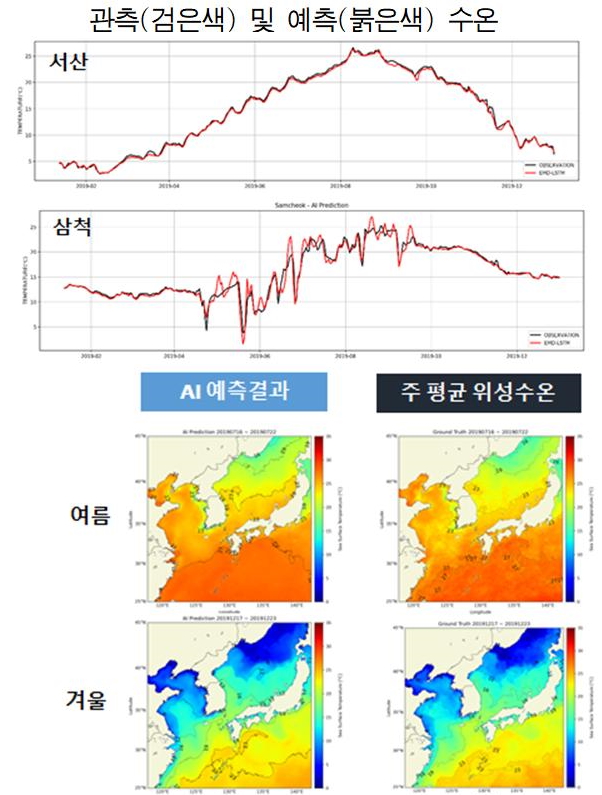
- Built a satellite (daily) and sensor-based (30-minute interval) big data collection system
- Dramatically reduced short-term water temperature prediction time based on artificial intelligence
- Results of short-term predictions (3-day forecast) of water temperature along the coast of Korea observed by artificial intelligence-based sensors:Short-term prediction analysis takes 0.5 hours (4 hours for numerical model), 87.5% reduction compared to numerical model
- Results of short-terms predictions (7-day forecast) of water temperature by artificial intelligence-based satellites:Short-term prediction analysis takes 1 hour (8 hours for numerical model), 87.5% reduction compared to numerical model
- Contributed to reducing damage from marine disasters by reducing forecasting time
- Analysis of information provided by low water temperature 65 times (2020-2021), high water temperature 43 times (2021), and cold water zones 9 times (2021)
[1] Succeeded in trait improvement of flatfish using genetic scissors technology
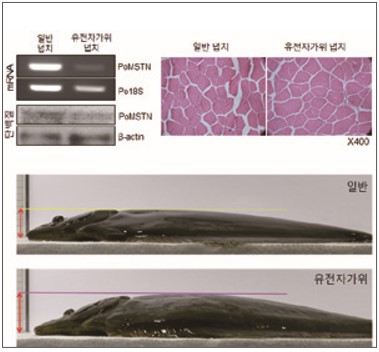
- Developed micro glass needle system and myostatin genetic scissors optimized for fertilized flatfish eggs
- Succeeded in microinjecting muscle growth-related (myostatin) genetic scissors
- Genetic scissors for flatfish myostatin gene knock-out (Patent Application No. 10-2018-0154742)
- Established flatfish genetic scissors technology and produced flatfish with increased muscle mass
- About 25% increase in efficiency of myostatin gene scissors and muscle (width) of similar body length in 1st generation production
- 2020 Oceans and Fisheries Science and Technology Awards Academic Research 'Best Award' Award
[2] Development of on-site diagnosis kit for viral hemorrhagic sepsis
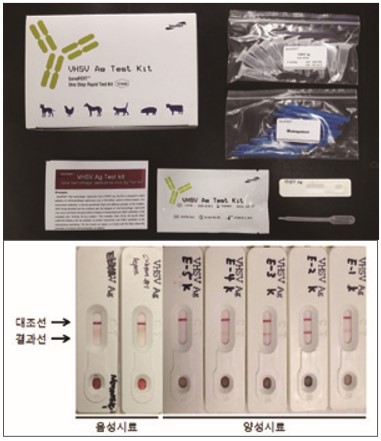
- Secured source technology for on-site diagnosis kits for surveillance of infectious diseases affecting aquatic organisms
- (Previous 1st diagnosis) On-site visual and laboratory diagnosis, 5 days, KRW 183,000 -> (After application) On-site antibody diagnosis, 20 minutes, KRW 25,000
- Verification of diagnosis for VHS types from all over the world through joint research with FLI (Friedrich Research Institute) in Germany
- It is possible to diagnose 11 genotypes separated by region and fish species in the world, as well as in Korea
- Succeeded in industrialization of medical devices for aquatic products for the first time in Korea by developing VHS on-site diagnosis device → Diagnosis in 20 minutes even by non-experts without expensive equipment!
- Acquisition of the first medical device item permission for technology transfer and fisheries (No. 123-049, 2020.1.)
- 2020 Ministry of Oceans and Fisheries, Government Innovation Best Practice Contest Excellence Award
[3] Developed jellyfish monitoring technique using mobile
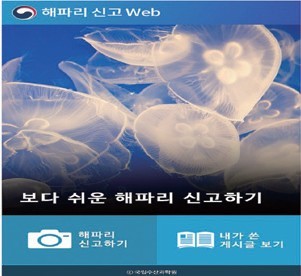
- Eliminated monitoring blind spots by developing monitoring techniques using mobile with public participation
- Reduced stinging accidents and minimized damage to fisheries by disseminating jellyfish appearance information quickly and accurately
- Accurate location based on mobile location, identification of jellyfish type with photos
- Prompt response to beach sting accidents to ensure public safety and prevent life-threatening accidents
- Promoted preemptive research through early identification of alien species due to climate change
- Established a system for predicting the movement and spread of jellyfish
[4] Saving lives with biologging technique of cod spawning journey
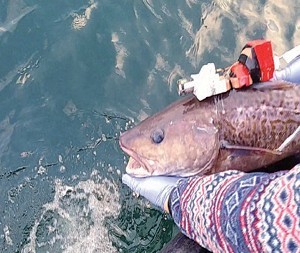
- Precise confirmation of cod breeding behavior using state-of-the-art biologging equipment for the first time in Korea
- Filmed breeding behavior from the perspective of a male cod for the first time (water depth 18m, water temperature 12.5℃, swimming speed 0.7-1.8km/h)
- Confirmation of spawning grounds in Daegu (Jinhae Bay), internal route, period, and main spawning area
- Up to 15-16 days in the spawning grounds, up to 7 days in the main spawning area
- Contributed to the preparation of sustainable resource management methods by collecting precise spawning ecological data
- Scheduled revision and implementation of the Enforcement Decree of the Fisheries Resources Management Act related to the fishing prohibition period and length (January 1, 2021)
[5] Developed low-salinity, biofloc-based, inland sea shrimp farming technology
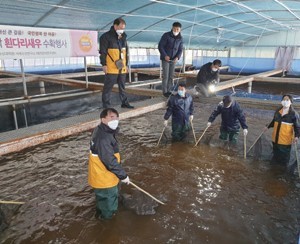
- Investigated minimum ion ratio of breeding water for inland farming of sea shrimp
- It is most economical when adjusting low-salinity breeding water with artificial sea salt in groundwater
- Reduction in additional ion input through discernment of lowest ion ratio → 60% cost reduction effect
- Proved possibility of mass production of vannamei shrimp with low-salinity biofloc technology using groundwater
- Salinity 4-8 psu, breeding period 147 days, average weight 25g, total yield 0.8 tons test production
[6] Identified the water level at which ichthyoplankton form through fishery resources survey
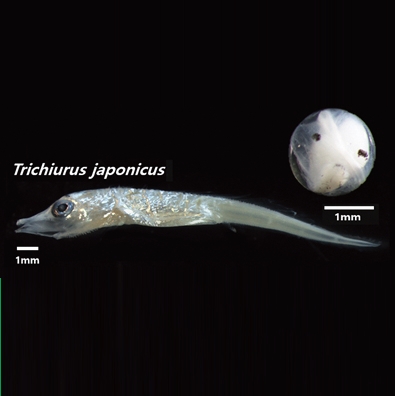
- Investigated and analyzed each water layer to ascertain the habitat environment of each fish species and reinforce the sea area survey of ichthyoplankton distribution using the advanced research equipment of fisheries science research vessels
- Use of multi-opening nets that can collect ichthyoplankton distributed in a specific water layer
- Investigated distribution by water layer of ichthyoplankton of 34 species, including hairtail, anchovy, horse mackerel, yellowtail, etc.
- Distribution of ichthyoplankton by fish species: horse mackerel (surface layer-10m) > yellowtail (10-20m) > yellowback seabream (20-30m) > damselfish (30-40m) > metallic lantern fish (40-60m) > dragonet (60-80m) > silvery lightfish (80-100m)
- Identified the ecological characteristics of ichthyoplanktons of major fish species
[7] Developed and industrialized oyster convenience food using fishy smell removal technology
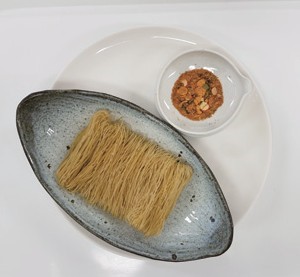
- Developed dried oyster powder to remove the soft texture and fishy smell of oysters
- Developed processed materials with increased savory taste and savory aroma components through multi-stage drying and roasting of steamed oysters
- Developed prototypes and products of convenience food containing oyster powder applied with fishy smell removal technology and transferred the technology
- Oyster rice noodles, oyster snacks (biscuits, chocolate chip cookies, fried rice), oyster tteokbokki
- 2 cases including National Federation of Fisheries Cooperative (manufacture of processed oyster products)
- Investigated preference through an internal fair for oyster rice noodles and snacks containing oyster powder
- Promoted research with online sales of processed oyster products through the 'Hallyeosudo Oyster Festival'
[8] Developed new raw materials for high-quality biodegradable nets
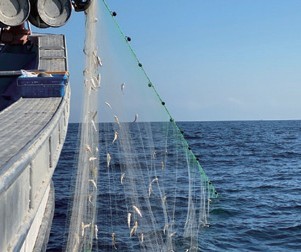
- Developed raw materials for biodegradable nets with improved strength, flexibility, degradability, and eco-friendliness compared to existing raw materials, and developed a high quality biodegradable net using new raw materials
- Laid the foundation for R&D and prompt field supply through collaboration between the private sector, industry, and research institutes
- 2 patent registrations, production of 2,500 tons of raw materials per year, and propagation for fisherfolk (supply in 2021)
- Through the development of various raw materials, it is possible to produce and supply suitable nets for each major fish species
- ncreased the effect of protecting fisheries resources by expanding the use of biodegradable nets according to quality improvement
[9] Established "Smart Fish Doctor (SFiD)", a non-face-to-face aquatic biodisease information sharing platform
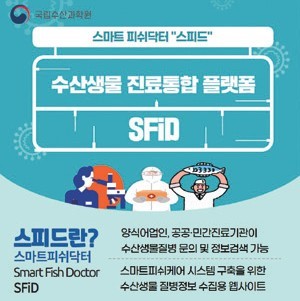
- Developed a customized online disease information sharing platform specialized for domestic aquaculture farms
- Poor face-to-face medical services can be supplemented by sharing real-time disease information via mobile
- SFiD registration information: ('19) DB 489 cases / 382 cases / ('20) DB 322 cases, clinical picture 148 cases
- Significantly shortened the number of days required for diagnosis by sharing disease information and consultation to aquaculture sites
- Number of days for diagnosis with Smart Fish Doctor: sharing disease information (1 day), sending cultured cells (1-2 days), rapid diagnosis kit (4 hours)
- Established preoccupation of useful resources and genetic information big data by expanding the collection of aquatic microbial resources
- 'Asset value of new resources in 2020': KRW 170 million (total asset value of 11 major types of assets is estimated at KRW 2 billion)
[10] Reduced damage from abalone farming online technical support at fisheries sites
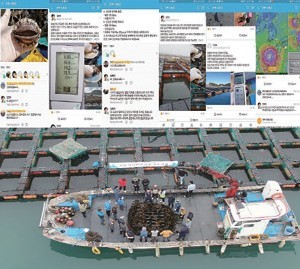
- Prepared and distributed "Abalone Rearing Management Manual"
- 'Abalone Rearing Management Manual for Fisherfolk' (published and distributed)
- Resolved real-time status identification and on-site difficulties through online two-way communication and information exchange
- Social media channel ('Abalone Sarangbang' band, 264 fisherfolk): 124 cases of online two-way communication
- Developed and applied a technical support model for fishery sites with consideration to social-distancing measures
- Specialized remote video technology training (2 sessions, 60 people), 'onboard technology training' in response to high-temperature (18 cases, 47 locations, 599 people)
- Reduced damage to aquaculture organisms by providing real-time information and prompt support in the event of a disaster
[1] Increased productivity through the industrialization of flatfish insect feed
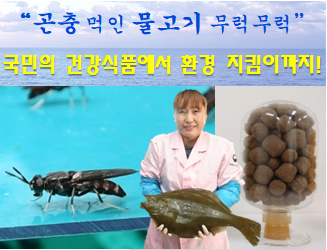
- Identified the excellence as functional aquatic food of flatfish raised with insect feed
- Realized early industrialization of insect compound feed through collaboration between the private sector, industry, and research institutes (farmers and insect industries)
- 5 cases of technology transfer within 2 years of starting the research, production of 300 tons of commercial feed for feed companies and distribution to 120 farms per month
- Expected to save about KRW 10 billion in foreign currency annually by localizing feed raw materials
- Realized social values such as protection of fishery resources and recycling of leftover food
- Received the 'Excellence Award' at the 2019 Responsible Operating Organization Service Innovation Sharing Competition
[2] Developed eco-friendly aquaponics technology based on biofloc (BFT)
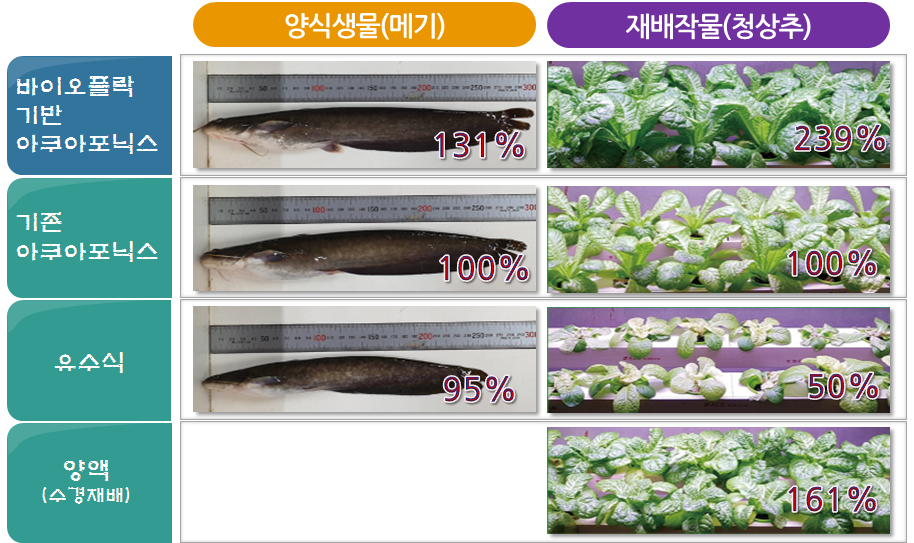
- Developed BFT eco-friendly convergence technology capable of producing antibiotic-free fish and pesticide-free vegetables(1 patent registration, 6 patent applications)
- Concluded technology transfer agreement with domestic industry for eco-friendly BFT-based aquaponics system (2 cases)
- Derived excellence in inter-departmental cooperation, such as establishing a fishery/agricultural convergence system
- Ministry of Oceans and Fisheries, Government Innovation Excellence Award in 2019
[3] Established an effective fishery resources management system using a scientific warning system

- Developed a traffic light evaluation system to provide status information on fishery resources
- Utilized ecosystem-based fisheries assessment (EBFA) method using GIS
- Developed risk prediction method based on ecosystem by time and space
- Provides visual information in the form of traffic lights according to the risk level of resource conditions
- Public-private partnership campaign and production of promotional videos to protect fishery resources
- Conducted 'Cheer Up', a campaign to protect juvenile fish, and promoted online and offline ('19.10.)
- Induced wise consumption and raised awareness of consumers for fishery resource management
[4] Utilized the red tide information system, reduced the forecasting period, and established a real-time control activity support system
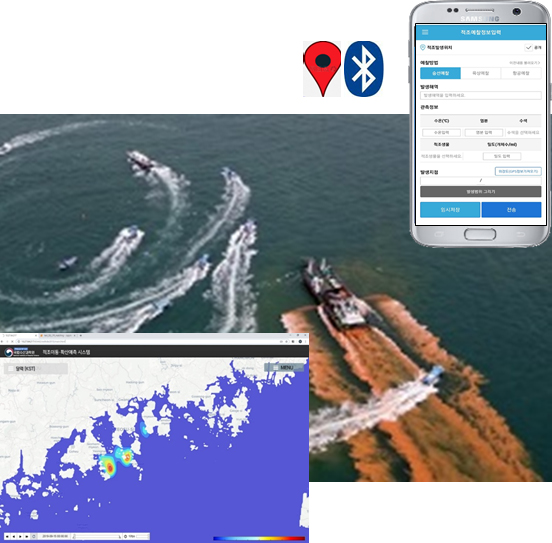
- Prompt red tide surveillance using GPS and Bluetooth functions of mobile phones
- Reduced production and provision time of Red Tide Breaking News by half (8 hours → 4 hours)
- Provided support for preemptive damage control by sharing red tide information in real time between related organizations
- Established a high-resolution red tide model based on big data, enabling red tide prediction up to 6 days in advance
- South Coast 100m resolution, 3 days (78%), 6 days (66%) prediction accuracy of red tide movement and spread
- Received the ‘Best Prize’ in the 2019 Marine and Fisheries Big Data Utilization Contest
[5] Developed loaches identification genetic marker to solve field difficulties of fisherfolk
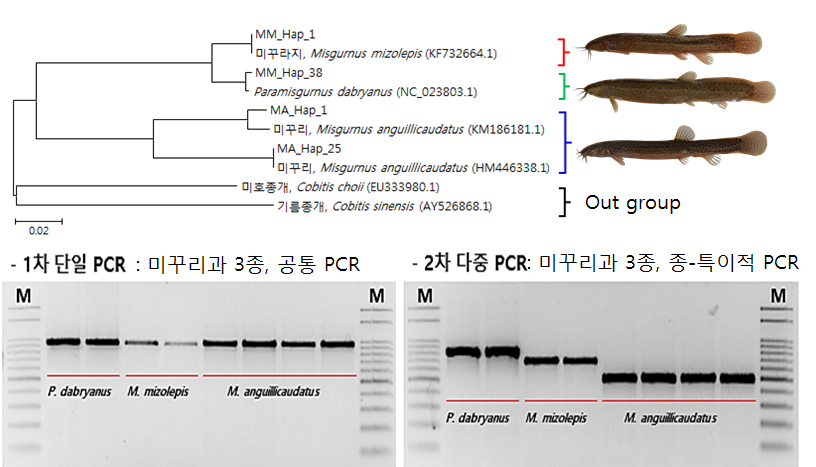
- Developed Cobitidae identification genetic analysis technology
- Genetic markers and identification methods for identifying fish species of the family Cobitidae (Patent Application No. 10-2019-0044741)
- Provided genetic analysis support for protection of the domestic loach farming industry and crackdown on illegal distribution
- Provision of genetic analysis information on 424 points from Saemangeum Regional Environmental Office, Han River Basin Environmental Office, etc.
- Reinforced practicality and expansion of public services among collaborating organizations, such as private and related organizations
- Technology transfer to industry for Cobitidae species identification gene analysis method (2 cases)
[6] Developed complete aquaculture and industrialization technology for cuttlefish
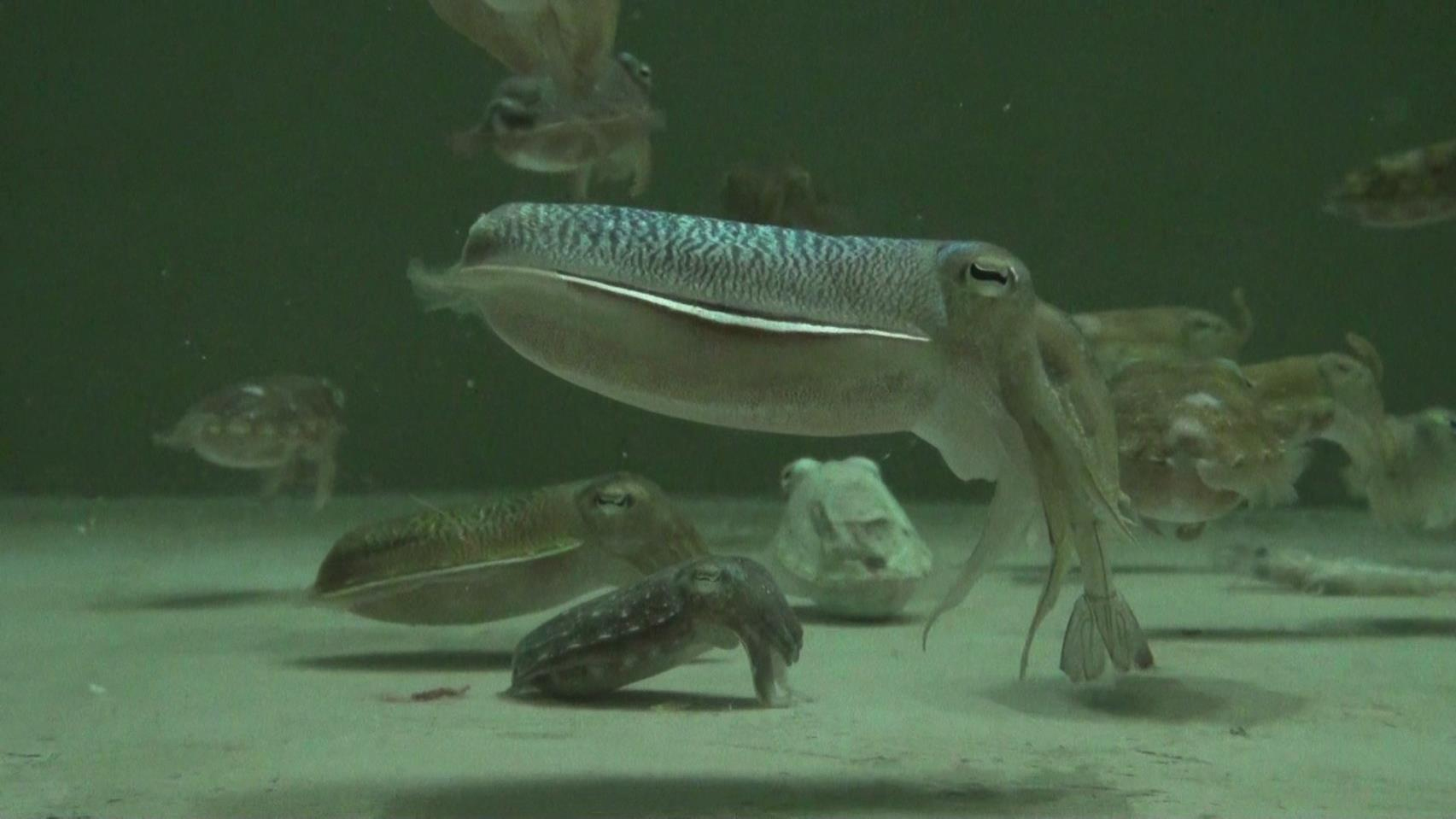
- Developed technology for complete aquaculture of cuttlefish for the first time in Korea
- Complete aquaculture succeeded in 2018 by rearing broodstock and securing artificial 2nd generation
- Induced 3-month early spawning for aquaculture industrialization (the main spawning season for wild cuttlefish is April-June)
- Promoted field application test research on aquaculture farm for industrial farming
- Aquaculture industrialization test through private collaboration and technology transfer
- Established early industrialization through development of on-site aquaculture technology (successful commercialization (300g) by breeding for 5 months)
[7] Developed a low-cost real-time water temperature observation system
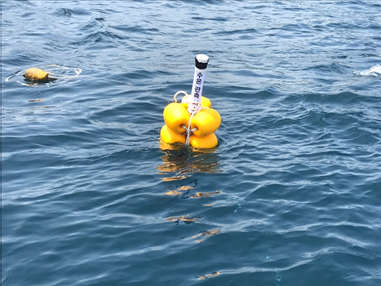
- Developed a water temperature observation system that is 50-75% cheaper than existing systems
- Existing systems, KRW 20-40 million vs. developed system, about KRW 10 million
- Real-time provision of water temperature data by water depth through mobile phone
- Selected for Gyeongsangbuk-do real-time water temperature observation system distribution project
- Distribution of real-time water temperature observation system can be expanded at low cost
- Contributed to reduction of damage to aquaculture organisms due to high water temperature and rapid water temperature change
[8] Mapped fishery resources and prey organisms based on SIMS (Survey Information Management System)
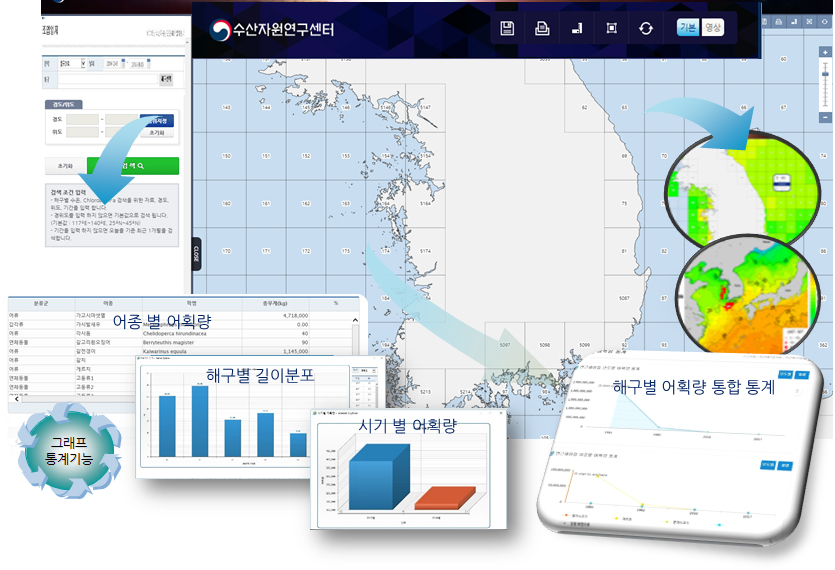
- Established standard and system of resource investigation using fisheries science research vessels
- Established an integrated system for managing survey information calculated through precise fishery resources surveillance
- Survey Information Management System (SIMS)
- Identified the distribution of prey organisms by season according to the close surveillance of fishery science research vessels
- Mapping of prey organisms: Contributes to research on indicator prey organisms, analysis of gastric contents of fish species appearing in coastal waters, and identification of food web structure according to oceanographic characteristics
[9] Developed short-term commercialization breeding technology for high-temperature strategic breed the hybrid grouper (Epinephelus fuscoguttatus x E. lanceolatus)
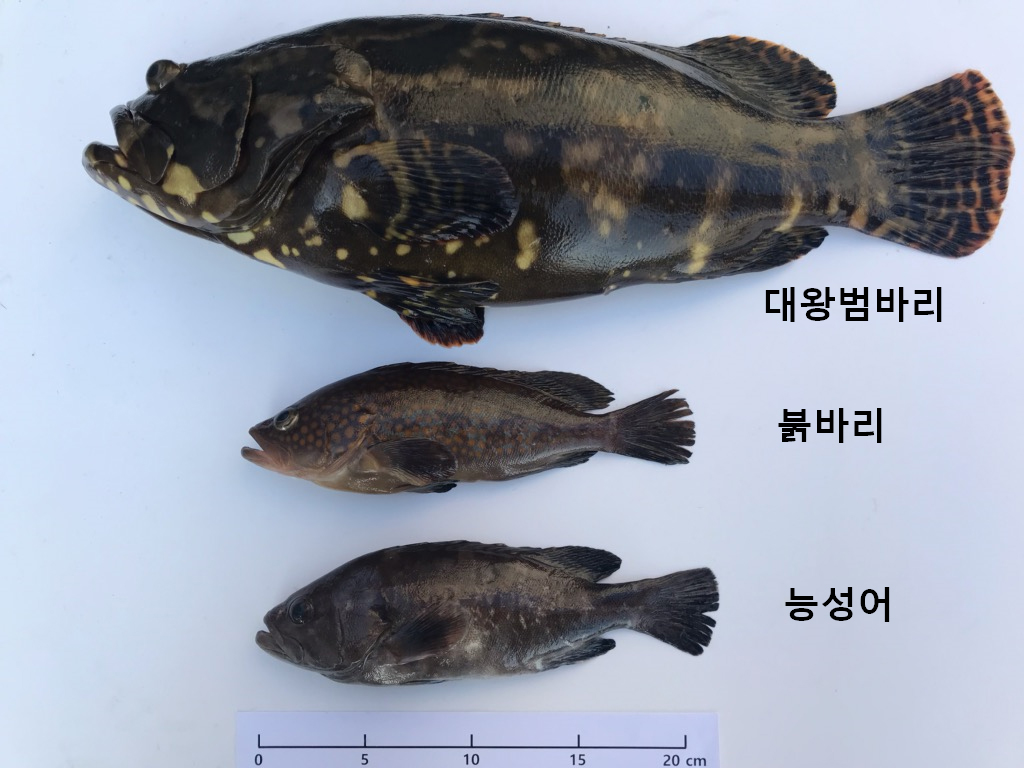
- Successfully commercialized the hybrid grouper (Epinephelus fuscoguttatus x E. lanceolatus with a weight of 1 kg or more within 1 year
- Possible to replace imports of more than KRW 5 billion per year (food: KRW 500 million, fishing: KRW 4.5 billion)
- Investigated biological characteristics of the hybrid grouper (Epinephelus fuscoguttatus x E. lanceolatus
- Can survive at 16℃ or higher, can grow at 21℃ or higher
- Identified the optimal farming method for the hybrid grouper (Epinephelus fuscoguttatus x E. lanceolatus
- Intermediate breeding (Circulation filtration/running water, water temperature maintained at 25℃ or higher) → growth (cage)
[10] Developed onshore smart aquaculture technology and model
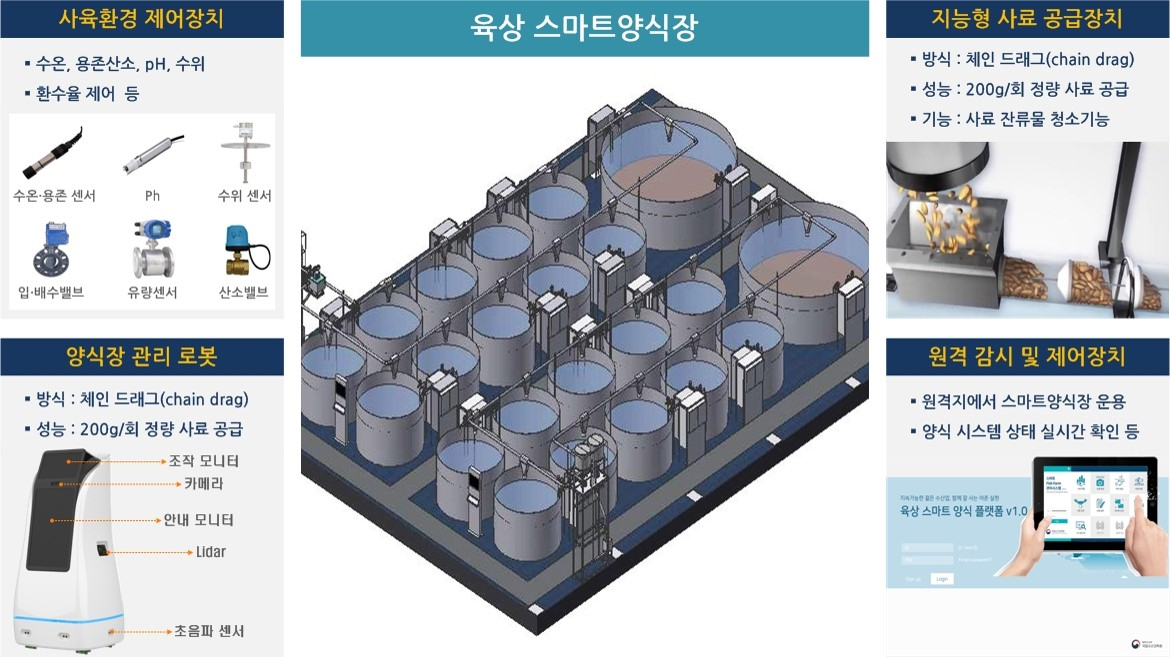
- Established onshore smart aquaculture platform and developed major core technologies
- Intelligent feed supply, breeding environment control, remote monitoring/control technology, farm management robot, etc.
- Non-contact fish counting device and counting method (Patent Application No. 10-2019-0116681)
- Developed a control system that can manage and operate farms in remote locations
- Laid the groundwork for identifying optimal breeding conditions for each breed in connection with artificial intelligence
[1] Developed eco-friendly smart farm management system
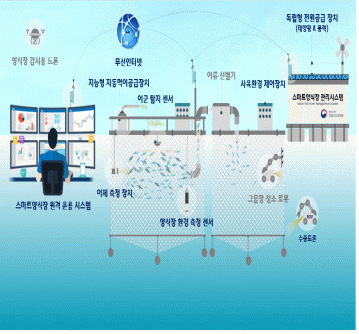
- Developed 4 major core technologies for offshore smart aquaculture for the first time in Korea
- Artificial intelligence feeding, fish growth measurement, underwater drone utilization, breeding environment control technology, etc.
- Secured the sustainability of a clean sea environment by operating eco-friendly smart fish farms
- Contamination indicator species rating: (General farm) Grade 3 → (Smart farm) Grade 2
- Applied and registered core technology and disseminated technology for early industrialization of research results
- Patent application: 1 case (No. 10-2018-0089129), technology transfer: 2 cases (No. 10-1677010, 10-1753221)
- Operated the Sea Change Advisory Group and demonstrated smart aquaculture technology ('18.10.31/Hadong, Gyeongnam)
- 2018 Ministry of Oceans and Fisheries, Government Innovation Excellence Encouragement Award (Minister of Oceans and Fisheries Award)
[2] Developed and industrialized high-quality seaweed seeds using advanced breeding technology
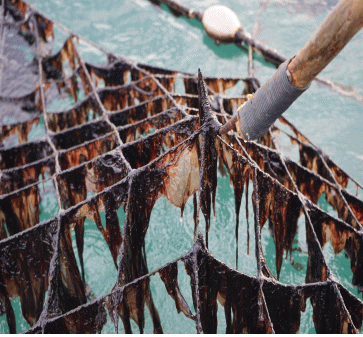
- Possessing world-class breeding technology by establishing advanced breeding technology for seaweed
- Led diversification of seeds and strengthened competitiveness of the seed industry by applying for and registering the right to protect varieties of seaweed
- 10 varieties applied (occupying about 50% of domestic application varieties), 4 registered varieties
- Occupying about 11% of domestic seaweed seed demand by industrializing national seaweed varieties
- 7 varieties, 114 non-exclusive license contracts, 380,000 boxes of shell filaments (equivalent to approximately KRW 1.3 billion in sales)
- Generated a total of KRW 71.6 billion in economic effects by supplying excellent state-owned varieties of seaweed
- Glass filament KRW 100 million → Shell filament KRW 1.3 billion → Fresh water laver KRW 4 billion → Dried laver KRW 66.2 billion
[3] Developed genetic markers for high-temperature resistant abalone selection
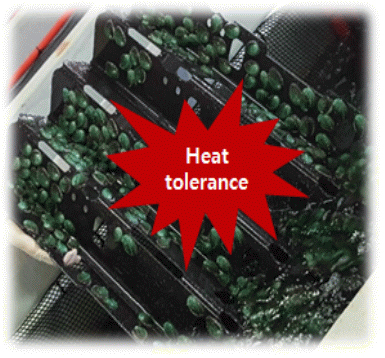
- Developed genetic markers associated with high-temperature resistance traits in abalone
- Secured high-temperature resistant breeding abalone, general abalone genetic diversity, and mutation information
- Secured about 16,000 items of significant single nucleotide mutation information
- Selected 52 high-efficiency single nucleotide mutation markers for high-temperature resistance traits
- Improved prediction accuracy of high-temperature resistance gene markers
- Established high-temperature tolerance ability prediction model according to genotype
- Improved accuracy through repeated testing and relearning modeling
- Selection accuracy: Breeding household abalone (70%), general farmed abalone (50%)
[4] Developed and industrialized seafood products to create a new consumption culture
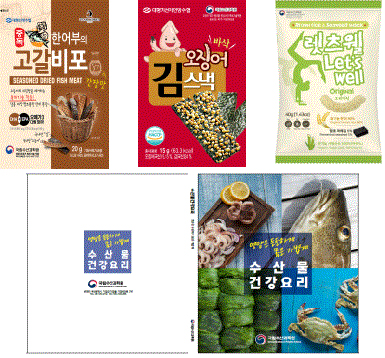
- Developed mackerel snack manufacturing technology using fishy smell removal technology
- 4 industrial technology contracts and 2 types of mackerel snack commercialization (Product names: Gogalbipo, Mackerel Cookies)
- Developed snack manufacturing technology applied with technology to improve squid’s taste compounds
- 1 industrial technology contract and 2 types of squid snack commercialization (Product names: Squid Rice Noodles, Squid Seaweed Snack)
- Developed seaweed puffed snack manufacturing technology using seaweed odor removal technology
- 3 industrial technology contracts and 1 commercialization of seaweed snacks (Product name: Let's Well)
- Published ‘Healthy Seafood Cuisine’ booklet
- Developed 55 kinds of healthy seafood dishes for school meals to form healthy eating habits
- Operated 'Fishery Products Experience Camp' and 'Fishery Products Cooking Class'
[5] Developed cuttlefish artificial seed production technology
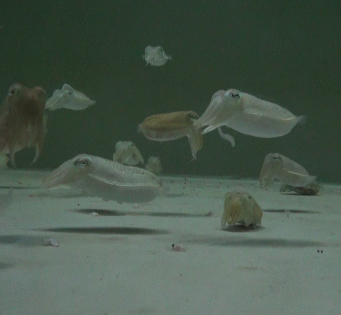
- Identified indoor artificial eggs and incubation water temperature
- Identified suitable attachment substrate for egg harvesting: trap > shellfish breeding net > abalone trap
- Identified optimum water temperature for incubation and the number of days required for incubation by water temperature: 20-25℃ optimum water temperature for incubation
- Identified early feeding of young cuttlefish and food for each stage of growth
- After hatching, 0.8 cm young cuttlefish are provided with adult Artemia as initial food
- Study on adequate feed for each stage of growth
- Artemia→Artemia+Mysidacea→Shrimp→Frozen Shrimp
- Growth: (immediately after hatching) 8mm → (95 days) 45mm → (165days) 110mm
[6] Developed eco-friendly integrated aquaculture (IMTA) technology
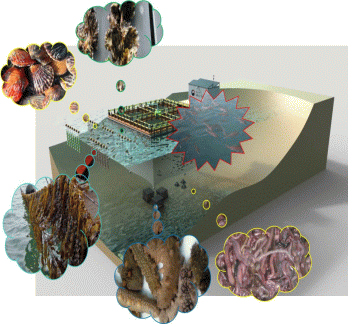
- Calculated appropriate aquaculture scale based on the ability of IMTA organisms to remove organic and inorganic substances
- Developed IMTA guidelines
- Demonstrated IMTA economic feasibility
- (Based on 0.5 ha of offshore fish farm) Total environmental benefit of KRW 136.4 million, net profit margin of sales of 37.8%
- Transferred core technologies for early industrialization of developed technologies
- 16 patent registrations, 2 technology transfers
- 2018 National Institute of Fisheries Science Fisheries Test Research Project, selected as the best project
[7] Developed high-efficiency compound feed for flatfish made of eco-friendly insect material
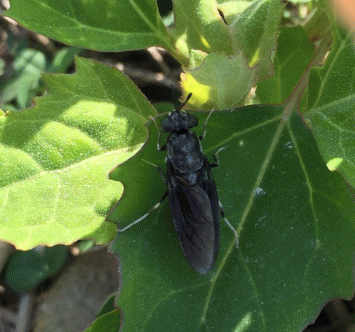
- Developed high-efficiency feed for flatfish made of insect material (2 types: for intermediate culture, for adult fish)
- Up to 30% of insect meal can be replaced with fish meal, and the use of insect oil improves growth and immunity
- Investigated the excellence of disease resistance of flatfish supplied with insect feed (58% improvement in relative survival rate)
- Investigated the excellence of flesh quality of adult flatfish supplied with insect material (lauric acid detection)
- Beneficial bacteria in the gut increased and useful microbial resources were secured
- Established eco-friendly aquaculture industry base and substitution effect of feed raw material imports
[8] Developed energy-saving anchovy towing net fishing gear
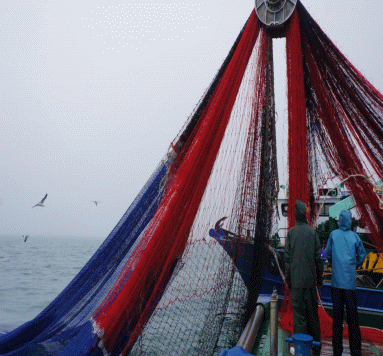
- Developed energy-saving anchovy towing net fishing gear
- Reduced fuel costs by more than 40% by reducing the shape and length of fishing gear
- Fishing gear length: (Existing) 700 m → (Developed) 430-470 m, less than 20% reduction in catch
- Reduced fishing equipment production cost by 25% (KRW 75 million → KRW 57 million)
- Reduced working time by 20% (Casting 5 minutes → 3 minutes, Hauling 25 minutes → 20 minutes)
- Applied for patent for energy-saving anchovy towing net fishing gear and disseminated the technology
- App lied for patent (No. 10-1816248), held 4 briefing sessions
[9] Developed Korean standard method of ecotoxicity examination for marine environment
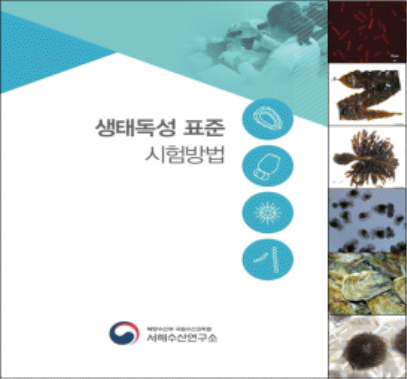
- Developed marine environment ecotoxicity examination methods
- Developed 6 ecotoxicity examination methods, focusing on the role of the marine ecosystem (phytoplankton, etc.)
- Published, distributed and provided training on 6 ecotoxicity standard examination methods
- Distributed 70 copies to the Ministry of Oceans and Fisheries, National Institute of Fisheries Science, local governments, and related research institutes
- Conducted examination method training for Korea Coast Guard, Research Institute, Pukyong National University, Marine Ecology Research Institute, etc.
- Announced the use of the 6 ecotoxicity examination methods as marine environmental examination methods
- First announcement of ecotoxicity examinatinon methods in the Article 'Korean Standard Method of Examination for Marine Environment' of the Marine Environment Management Act of the Ministry of Oceans and Fisheries
- Policy support and promotion using ecotoxicity test methods
[10] Established a foundation for aquaculture industry in Myanmar’s inland waters (ODA project)
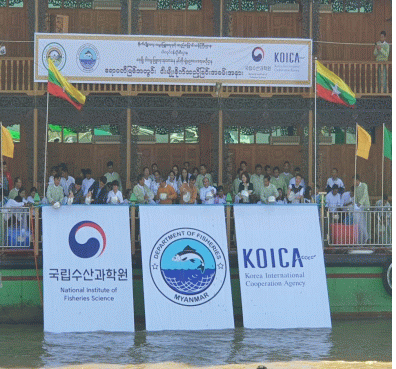
- Established and transferred Myanmar's first inland aquaculture industry development plan
- Invited management and working-level officials and provided on-site training to strengthen fishery policy and practical capabilities (total of 46 people)
- Provided Myanmar Inland Aquaculture Research Center operation support and technical training
- Provided education on aquaculture techniques such as broodstock management, seed production, rearing, disease, and water quality management
- Released fish seeds jointly produced by Korea and Myanmar (200,000 fish, 3 species including Rohu)
- Successful operation of the Myanmar Inland Aquaculture Research Center, reported by about 10 media outlets including state TV
- A successful example of the inland aquaculture center in Myanmar, raising interest in neighboring countries in Southeast Asia (Thailand, etc.)
- Reported by Yonhap News and many other media outlets in 2018 (Korea’s advanced aquaculture technology kicked off the Korean Wave in aquaculture)
[1] Reduced damage to fisheries through field-oriented research
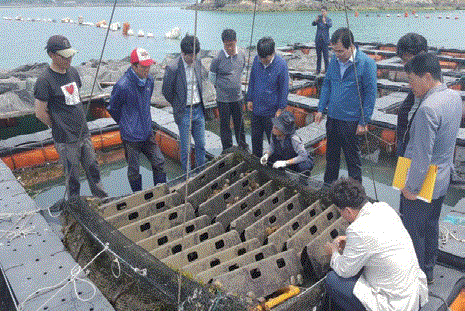
- 43.3% reduction in the rate of reporting damage to aquaculture organisms through the preparation of active damage response plans
- Operating a joint field response team with local governments, inspected breeding conditions, and guided and publicized improvement plans
- Decreased abalone mortality rate through rearrangement of an abalone cage farm (52.4% → 6.9%)
- Reduced damage to rockfish from cage farming in Cheonsu Bay (KRW 5 billion in 2016 → KRW 0 in 2017)
- Reduced mortality rate from 40% → 17.3% and production cost by 30% by disinfecting culture water at Jeju flatfish farms
- Reduced damage to cage farms (KRW 9.1 billion in 2016 → KRW 3.7 billion in 2017)
- Contributed to increasing fisherfolk's income and stabilizing the supply and demand of aquatic products through the reduction of damage to aquaculture organisms
[2] Established and industrialized mass production technology of natural products for fisheries
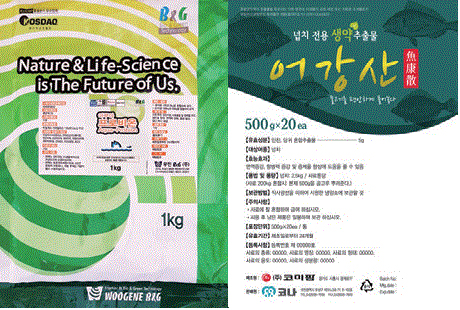
- Developed eco-friendly microbial probiotics and injin/dong quai herbal medicines
- Established mass production technology for industrialization and sold probiotic products for fisheries
- Investigated antibacterial properties of injin/dong quai herbal medicine extracts and registered patent of source technology
- After establishing the development process and standardization of natural medicines for aquaculture, transferred technology to the industry (4 cases)
- Replaced antibiotics with microorganisms and herbal medicines that are harmless to the human body, increasing the safety of seafood
- Included in ‘2017 Top 100 Outstanding National R&D Achievements’ by the Ministry of Science and ICT
[3] Succeeded in producing the world's second artificial breed of yellow tail
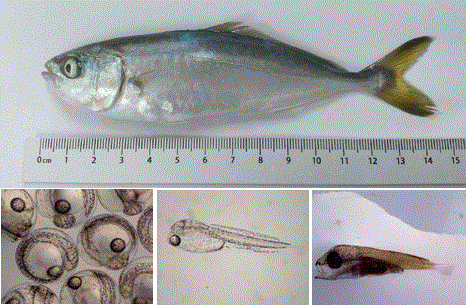
- Established natural broodstock management technology in inland water tanks for stable egg production
- Developed fertilized egg production technology (established sexual maturation technology through light and water temperature control)
- Succeeded in mass production of fertilized yellow tail eggs: 7,129,000 (69.4% normal fertilized eggs)
- Successful production of artificial yellow tail: 7,100 (size 68-90 mm)
- Featured in 58 reports, including KBS·MBC·JTBC News, Dong-A Ilbo, Yonhap News, etc.
[4] Maximized post-harvest processing efficiency by developing an automatic sea squirt sorting system
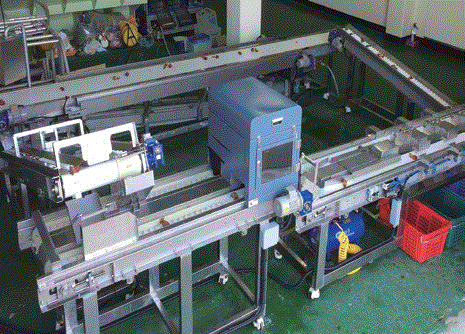
- Developed technology to sort sea squirts by size by sorting by-products based on image processing technology
- Composition: Image processing device, sea squirt transport conveyor belt, washing/sorting device, sorting device
- Performance: Sorting accuracy 98%, sorting speed over 1.5 tons/hour
- 30% reduction in sea squirt production costs and manpower (KRW 25 million/ household/year)
- Registered 2 patents, including 'Automatic sorting and classification device for sea squirts using vision system'
[5] Established and utilized cold water mass occurrence prediction system
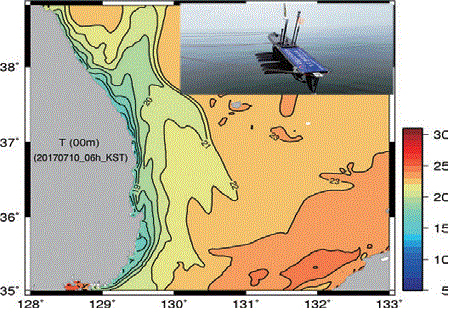
- Established a high-resolution cold water mass prediction system based on atmospheric-sea combined numerical model
- Forecast information for the next 3.5 days is provided every hour
- Provided prediction information on the occurrence and disappearance of cold water massin August 2017
- Succeeded in predicting the occurrence of cold water mass in the middle and southern part of the East Sea in July 2017 and in the southern part of the East Sea in late August
- An estimated KRW 7 billion in aquaculture damage was reduced by predicting the occurrence of cold water mass in the summer of 2017
- Featured in 15 reports, including Kyunghyang Shinmun, Yonhap News, and Kookje Daily News
[6] Restored the extinct Geumgang long snout bullhead (宗魚)
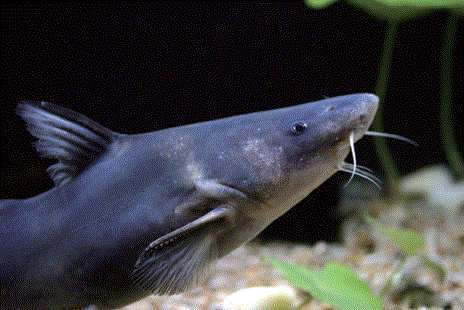
- Succeeded in cultivating mothers and producing artificial seedlings after introducing young Chinese long snout bullhead (Leiocassis longirostris Gunther)
- Transferred seedling sales and artificial seedling production technology to local government research institutes
- Released juvenile fish and female candidates for restoration of fish resources into the Geum River ('08, '15, '17)
- After the first catch ('17.5) in the Geumgang River, 19 released individuals have been recaptured so far
- Promoted the ‘Jongeo restoration achievement' to the public on KBS news, etc.
- Adopted the negotiation agenda of the 8th Korea-China high-level fishery talks (long snout bullhaead breeding technology exchange)
[7] The world's first successful artificial breeding of ornamental sea shrimp (cleaner shrimp)
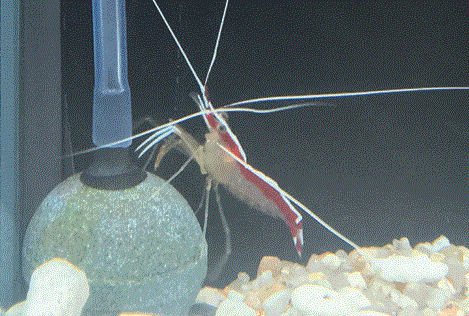
- The world's first successful production of junvenile ornamental sea shrimp (cleaner shrimp)
- Supply of cleaner shrimp is entirely dependent on natural collection, and it is traded in large quantities at high prices in the ornamental market
- International transaction price (per unit): KRW 6,000 (before '10) → KRW 15,000 ('13) → KRW 30,000 ('17)
- Developed key technologies (water quality and nutrition management, formula suppression) required for young shrimp production
- Expected to generate high income (worth KRW 3 billion per year) by commercializing cleaner shrimp aquaculture technology
- Featured in major media reports (37 cases), including KBS News, Seoul Shinmun, and Kookje Daily News
[8] Developed and industrialized a brand of fast-growth breeding abalone
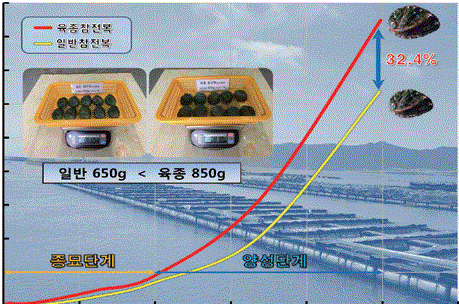
- Developed fast-growth (30% faster growth) breeding abalone using selective breeding technology
- Comparison of average weight at 26 months after fertilization: Breeding abalone (84.2g) > General abalone (63.6 g)
- Disseminated field tests and monitored growth traits of abalone
- Supplied 150 million larvae and monitored growth traits at 15 locations in Jeollanam-do from 2015-2017
- Developed fast-growth breeding abalone brands (King Abalone, King Junbok) for industrialization
- Reduced production period (6 months) and production cost (KRW 5,500/kg) of fast-growth breeding abalone
- Featured in 40 reports on SBS, KBS, Yonhap News, etc.
[9] Investigated the spawning and breeding ecology of herring and cod that originate in Jinhae Bay
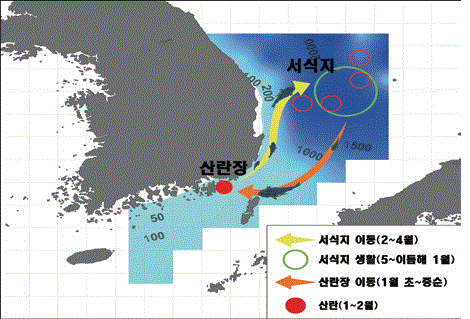
- Identified characteristics and spawning quantity of herring spawning grounds in Jinhae Bay
- Seaweed colony within 5m depth, approximately 150,000 males and females participate in spawning, approximately 5.3 to 34 billion fertilized eggs
- Utilizing electronic tags, explored the migration range and habitat environment of cod born in Jinhae Bay by period
- Identified cod in the North East Sea, South East Sea, and West Sea by diet and genetic differences by sea area
- Supported the revision of the Enforcement Decree of the Fisheries Resources Management Act (capture prohibition period) (‘16. 5.)
[10] Developed flatfish farming energy-saving technology
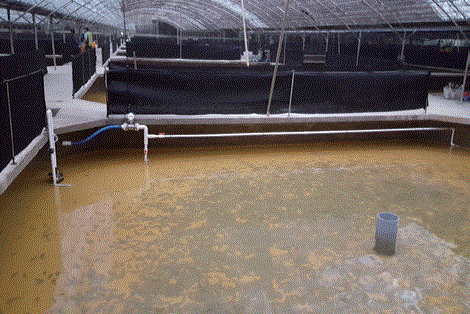
- 80% reduction in water exchange by applying rearing water disinfection technology to flatfish farm
- Even if the water exchange is reduced by 80% (30 cycles/day → 6 cycles/day), there is no difference in growth, survival rate, or health
- Decreased flow rate due to reduction in water exchange → Decreased flounder motility → Improved feed efficiency
- Expected to save more than KRW 22 billion in annual electricity bills in Jeju
- 15 cases of flatfish farming guidance (farmers, fisherfolk, local governments, etc.)
[1] Succeeded in developing the world’s first complete aquaculture technology for pollack
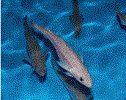
- Came to possess world-class fishery technology (reduction of growth period)
- Successful maturation of pollack in 1 year and 8 months (takes 3-4 years in nature)
- After mass production, imports (228,000 tons) are expected to create economic effects of about KRW 400 billion
- Mass production and release of pollack seedlings not only restores pollack stocks on the East Coast, but also shortens the industrialization period for pollack farming
- 2016 Ministry of Oceans and Fisheries ‘Government 3.0 Best Case Contest’ Excellence Award
[2] Developed the world's second complete aquaculture technology for eels
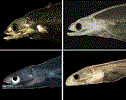
- Developed original technology for complete aquaculture of eels (2nd generation production)
- By 2020, it is expected to account for about KRW 4 trillion of the world eel seedling market by securing mass production technology and industrialization
- Contributed to increasing eel natural resources and saving about KRW 400 billion in annual seedling costs
- Included in ‘2016 Top 100 Outstanding National R&D Achievements’ by the Ministry of Science, ICT and Future Planning
[3] The Miracle of the Sahara Desert! Succeessful Shrimp Farming Project
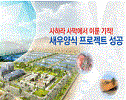
- Began Sahara Desert shrimp farming research center construction project and technology transfer (2011)
- Completed Shrimp Farming Research Center and successfully mass produced farmed shrimp (2016)
- Harvested 500 kg from indoor farms in January and harvested 5 tons from indoor and outdoor farms in October
- Established a bridgehead for domestic aquaculture equipment and construction companies in Africa
- Enhanced international awareness according to requests for aquaculture technology cooperation from international organizations
- Awarded the grand prize at the 2016 Ministry of Interior ‘Government 3.0 Outstanding Case Contest for Special Operating Agency’
[4] Developed and industrialized aquatic food tailored to youth

- Developed fishy smell removal technology (patented)
- Method for removing fishy odor and preventing oxidation of fatty acids (Patent No. 10-1647778, ‘16.8. 5)
- Transferred fishy smell removal technology to industry (2 cases)
- Cooperative of Large Purse Seine Fisheries (mackerel processed food), Cooperative of Large Pair-Trawl Fisheries (Japanese Spanish mackerel processed food)
- Promoted commercialization of mackerel snacks, mackerel cutlets, squid pizza bread, seaweed soup, etc.
- Awarded the grand prize at the 2016 Ministry of Oceans and Fisheries ‘Government 3.0 Outstanding Case Contest’
[5] Developed gene identification technology to determine the country of origin of marine products
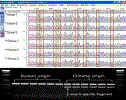
- Completed species classification and barcoding of 600 major aquatic organisms
- Developed a marker to determine the country of origin of salted shrimp, which has frequent origin disputes
- Advanced genetic identification technology for determining the origin of salt shrimp (saving time and expenses)
- Established a search system for aquatic product genetic identification information (species, country of origin, etc.)
- Registered a patent and transferred technology of Chinese salt shrimp origin determination gene (Fisheries Cooperative)
- Included in ‘2016 Top 100 Outstanding National R&D Achievements’ by the Ministry of Science, ICT and Future Planning
[6] Produced the world's first abalone genome map

- Completed genome sequencing of abalone (1.8 billion) and completed the genetic linkage map
- Constructed a genome database and developed a genome browser
- Investigated evolutionary characteristics and discovered useful genes through comparative genome analysis
- Developed genetic markers for classification of abalones in Korea (4 types, including disk abalone)
- Induced breed improvement using genetic markers associated with industrialization traits
- Included in ‘2016 Top 100 Outstanding National R&D Achievements’ by the Ministry of Science, ICT and Future Planning
[7] Developed high-efficiency vaccine against fish scuticociliate
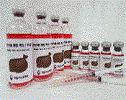
- Registered a patent for an optimal fish parasite prevention vaccine (No. 10-1677947, '16.11.15.)
- Selected as the best domestic seed vaccine and secured source technology for vaccine manufacture
- Transferred vaccine patent technology to veterinary drug companies (5 vaccine manufacturers)
- More than KRW 36 billion/year in productivity improvement is expected, due to reduction in mortality as a result of vaccine use
[8] Responded to marine disasters using real-time marine environment information system
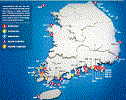
- Provided real-time information to minimize damage to fisherfolk ('03 onwards)
- Provided real-time information through social media, online/mobile website, and a smartphone app
- 4,500 social media service subscribers, 12,000 app downloads
- Provided customized information for fisherfolk through collaboration with local governments/private organizations
- Collaborating institutions: Jeonnam Institute of Maritime Science and Fisheries Science, Wando-gun, Korea Gas Corporation
- Actively used to respond to abnormal sea conditions such as cold water zones, high water temperature, low water temperature, and low salinity
[9] Conserved protected marine creatures, such as finless porpoises and spotted seals
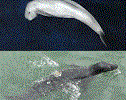
- Since the bycatch of 8 control porpoises and 55 finless porpoises in the monitoring sea area, attaching a bycatch-reducing escape net to the stow net has resulted in no bycatches (0 porpoises)
- Wild adaptation training for bycatch young spotted seals, successful release in the wild, and tracking/confirmation of movement routes using satellite tracking devices
- Actively contributed to conservation measures for marine creatures subject to protection (Marine Ecosystem Act)
[10] Developed an eco-friendly recycling system for carcasses in cage farms
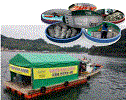
- Developed a marine creature carcass treatment device and system (2 patents applied for and registered) and transferred technology to the private sector (fishery quarantine and fertilizer producers)
- Patent application (No. 10-2016-0033426. '16.3.21), patent registration (No. 10-1655065, '16.9.1)
- Successful pilot project through public-private-institute collaboration (processing 62 tons of carcasses in 2 regions)
- 50-95% reduction in treatment costs through recycling of carcasses, and enhancement of resource use value through production of high-efficiency organic mixed fertilizer raw materials (34 tons)
[1] roduced world's second complete aquaculture of bluefin tuna
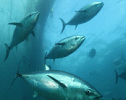
- The first in Korea and the second in the world to successfully produce fertilized eggs (304,000 ea)
- First successful seedling production using fertilized eggs in Korea (5-7 cm, 2,026 fish)
- In 2015, carried out intermediate breeding and winter breeding of 1,412 artificial seedlings and 11 produced in 2014
- Secured domestic broodstock candidates and carried out breeding management (5-year-old, 4-year-old, 3-year-old)
[2] Succeeded in seedling production by procuring pollack mother fish for the first time in Korea
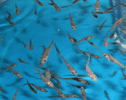
- The world’s second successful seedling production and procurement of a pollack parent fish through a public-private-university- research institute collaboration system
- Investigated the cause of pollack death and improved survival rate
- Applied for a patent for a low-temperature feed organism development device
[3] Developed industrialization technology for giant river prawn cultivation
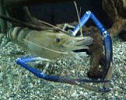
- Developed complete aquaculture production technology for the current year through seedling production (production completed between February and October)
- Reduced feed costs by developing ecological aquaculture technology and utilizing natural energy
- Fostered seedling production and breeding enterprises (2 seedlings, 10 fostering)
- Laid the foundation for the giant river prawn farming industry by fostering aquaculture companies
- Produced and sold 800 kg of giant river prawns (seedling production, expansion of industrialization base)
[4] Developed fast-growth breeding abalone and disseminated of field tests
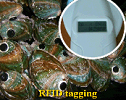
- In 2015, produced fast-growth breeding abalone production and distributed field tests
- By the 90th day, the growth trait (average leg length) had grown more than 20% faster than in the control group
- Fast-growth breeding abalone production period and cost reduction effect is predicted
[5] Developed rhubarb-derived whitening active material and transferred technology
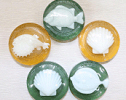
- Developed whitening active material from rhubarb (1 type)
- Effect is more than 100 times stronger than arbutin, an existing whitening cosmetic material
- Patent application and technology transfer to related companies (2 companies)
- Developed prototypes of whitening soap and whitening cosmetics
[6] Developed rapid bacterial disease diagnosis kit
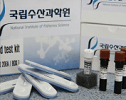
- Reduced bacterial disease diagnosis time (3-4 days → 10 minutes-3 hours)
- Developed an on-site immune rapid diagnosis kit and a molecular diagnosis kit for precise diagnosis of 3 types of flatfish bacterial diseases (Streptococcal disease, Edward's disease, and Vibrio disease)
- Expenditure savings of more than KRW 50 billion through prompt diagnosis and initial treatment of flatfish disease
- Prompt licensing and transparency of drug information with one-stop electronic civil application system for marine medicines
[7] Prompt licensing and transparency of drug information with one-stop electronic civil application system for marine medicines
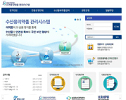
- Opened electronic civil application system website for aquatic drug
- Administrative procedures such as receipt and notification of civil complaints for permits are reduced by more than 11 days
- Developed fishery medicine management function and strengthened linkage with other institutional systems
- Ministry of Maritime Affairs and Fisheries, Government 3.0 Excellence Contest (in the field of working style innovation)
[8] Developed antimicrobial peptides derived from aquatic organisms
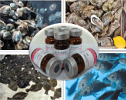
- Developed functional antibacterial peptide material from flatfish, abalone, and oyster
- Succeeded in mass producing recombinant antibacterial peptides in E. coli system
- Patent application and industrial technology transfer
[9] Developed the world's first mass-cultivation technology for red tide organisms
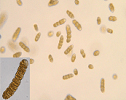
- Cochlodinium culture 5,000 cells/mL, 500 liters cultivated and secured throughout the year
- Contributed to revitalization of research on red tide damage reduction by distributing cultivars to institutions and academics (13 times, 350L)
- Investigated optimal growth conditions of red tide organisms and relationships between environmental factors
[10] Rescued, treated, and released endangered cetaceans
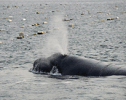
- Rescued, treated and released into the wild endangered cetaceans such as the northern right whale, southern bottlenose dolphin, and porpoise
- Maintained the rare cetacean population at a certain level and provided an opportunity to raise public awareness of endangered species protection
- Prepared measures to reduce bycatch, such as gear escape devices and sound warning devices

